

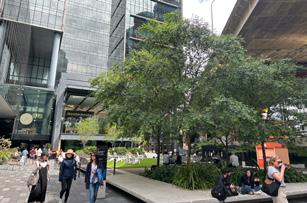










Holly and I both enjoyed breaks over the festive season and we know that many in the membership, too, were off to far flung places in search of rest and recreation and are now re-charged for the year ahead.
We returned to our desks and a variety of contributions from VPELA HQ and our members. Like all good editors, we’ve also managed to wrangle contributions from some we know have always wanted to contribute but have been too shy to do so.
This Autumn edition includes the usual recap of VPELA’s calendar of events since the last edition, including:
• A light-hearted review of the Christmas Party at Zinc sent from a mystery email address
• The announcement of the inaugural winner of the Kathy Mitchell Award – Amaya de Silva
• Christina McRae’s report on last year’s Sydney Study Tour
• Colleen Peterson’s report on the very recent Wind Farm Study Tour
• Meredith Gibbs seminar article about a future legislative framework for Victoria’s waterways.
It also includes informative snippets in the In case you missed it column, contributions from the YPG Co-Convenors, and some professional and personal background on two new Board members.
Our President provides a timely reminder of the Government’s promised rewrite of the Planning and Environment Act and the preparation of a new planning strategy for the whole of Victoria. From time to time, many of us find ourselves saying ‘here we go again’ but there’s always value in getting involved in these processes and Mark invites membership participation in, and foreshadows VPELA’s contribution to, both initiatives.
Also in his column, the President observes that time is marching for the Government’s new housing supply ambitions. Is there any real hope for the delivery of the vast numbers needed, or has it set itself

 Amanda Ring, Director, UPco
Amanda Ring, Director, UPco
up for failure? Four articles in this edition address these housing ambitions from different angles:
• The Shadow Minister, James Newbury MP, is welcomed to Revue and he writes about, amongst other things, the impact of rapid change, the value in working with the development and property industries, and the need for a “massive pair of scissors” [to] “cut through red tape”.
• Rob Burgess writes a great article about housing targets – are they helpful and realistic and how could they be improved as a planning tool?
• Chris Hayton speaks concisely about the flaws of the wellintentioned Future Homes program.
• Matthew Townsend alerts us to the ‘handbrake’ that covenants can be on sharing access to some of our most valuable urban land.
While a little delayed, we’re also delighted to have a summary of Kelley Mackay and Will Young’s Transforming Melbourne… presentation at VPELA’s ’23 annual conference. Professor Alan March, University of Melbourne, provides the first of what we hope will be regular contributions from the tertiary institutions educating the next generation of VPELA members. Peter Malley reveals he’s more than a numbers man with his thoughts on road pavement width. Finally, Rory Costelloe shares his experience of walking the Kokoda Track and its life changing impacts. The Track, together with Geelong Youth Engagement’s ability to get troubled youngsters on a happier, productive and fulfilling path, is topical at a time when media outlets report increasing youth crime, homelessness and disadvantage. There’s nothing like a bit of perspective, is there?
Thank you to all our contributors – you make Revue possible –regardless of the contribution being great or small. Enjoy reading this Autumn edition and, as always, we look forward to feedback.
Amanda Ring and Holly McFall are both part of the team at UPco

It’s always interesting, if not nostalgic, to look back on the early days now that VPELA, in 2024, is 35 years young. The team at VPELA HQ has compiled some historical ‘deets’ to jog your memories and prompt some reminiscing amongst peers, colleagues and friends. We started searching long past editions of the early days Newsletter and Revue, with a laser focus on photos (of course, we did) leaving us to ponder: where does all the time go? Eds
Membership
1990: 177 members
2024: 1147 members
• Inaugural AGM 20 July 1989
• First VPELA Seminar “The Administrative Appeals Tribunal – The Way Ahead” 21 September 1989
• First Annual Dinner 1991
• First State Planning Conference 1993 in Ballarat
• Just 7 Life Fellows
• Richard J Evans Award established in 1991 with its first recipients being Evan Walker and Allan Hunt – both former Ministers with responsibility for the State Government’s planning portfolio
• The first Newsletter published November 1989
• 119 issues of Revue (and its predecessor) to date.
Presidents
Peter Barber 1989 – 1997
Jane Nathan 1997 – 2000
Henry Turnbull 2000 – 2002
Ian Lonie 2002 – 2004 (deceased)
Kathryn Mitchell 2004 – 2011
Tamara Brezzi 2011 – 2022
Mark Sheppard 2022 to date.






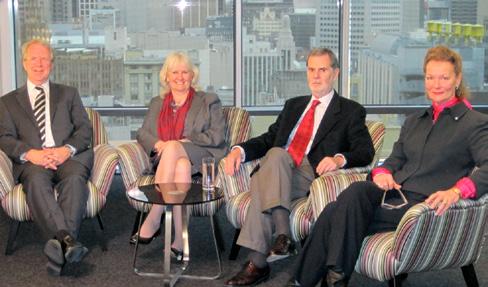
Happy New Year! 2024 promises to be a big one for planning and environmental law in Victoria given the scale of the Victorian Government’s reform ambition.
Notably, the Government has promised a rewrite of the Planning and Environment Act with the aim (among other things) of clarifying the roles, responsibilities and timeframes for decisions – including those of the Planning Minister and DTP. We welcome the news that this is to be a complete overhaul, similar to the amendments to the Environment Protection Act, rather than merely ‘tinkering around the edges’.
We understand the Minister is also considering further reform of the EES process, following a refresh of the Ministerial Guidelines in December. This is important and timely given the number of energy transition projects that will need to be assessed and approved in the coming years.
As always, VPELA will be contributing ideas for these reforms, and members interested in assisting should reach out to your friendly board member.
The Government has embarked on the preparation of a new planning strategy for the whole of Victoria, which is set to replace Plan Melbourne. It proposes to do no less than reimagine the future of the State.
The development of a new plan for the period to 2050 less than seven years after the release of Plan Melbourne 2017-2050 (itself the fourth strategy for Melbourne in 15 years, three by Labor governments) is a stark reminder that the environment in which planning operates can change rapidly, rendering best-made plans obsolete. How to respond? While another pandemic may be unlikely in the near future, our increasingly unpredictable climate, changes to housing, working and shopping needs and preferences, and the ongoing evolution of the global economy and transport technology, mean that any long-term plan must be dynamic. Perhaps, rather than a static blueprint, Plan for Victoria should contemplate a range of possible futures, and identify what levers might be pulled in different circumstances to ensure Victoria develops in a fair, sustainable and prosperous way.
I encourage members to get involved in providing solutions to the many planning and environmental challenges facing the State as it grows rapidly. Please contact me if you are interested in contributing to VPELA’s submissions on Plan for Victoria.

With almost six months already elapsed in the quest for 800,000 additional homes in 10 years, achieving this target is only getting more difficult. Innovative thinking is required to ensure that planning processes are carefully attuned to where they are needed, and designed to encourage the market to build in desired locations.
Codification is certainly a step in the right direction in terms of removing unproductive planning processes, providing greater planning certainty, and reducing the time and cost of obtaining a planning permit. Can this approach be expanded beyond ResCode to incentivise investment in preferred growth areas such as activity centres?
It is way too soon to definitively assess the success of Phase 1 of Future Homes. But its enhanced amenity and sustainability outcomes clearly come at a cost. So, it is imperative that Phase 2 stays the course of offering 5 storeys on well-served GRZ land, to offset this increased cost with greater development potential.
How else can planning facilitate housing growth, in the right location? Is it time for our planning schemes to go on a diet, to remove the unnecessarily bespoke provisions that have swollen the originally slimline new format schemes, needlessly stretching out planning assessments?
What about our residential zones? Are they appropriately deployed taking into account the Holy Grail of 70:30?
The Government’s grand ambition invites grand ideas. We will continue to engage with the Planning Minister and DTP to provide industry perspectives and a sounding board for reform ideas, and we welcome your contributions.
Congratulations to Anna Borthwick and Eliza Minney, who were elected to the VPELA Board late last year. They bring valuable experience and ambitions for the Board, as outlined in the following pages. And heartfelt thanks to Christina McRae, who completed a very active six years on the Board and Adam Terrill for his service over almost a decade including three years as Vice President.
Mark Sheppard is President of VPELA and a Director at Urbis.

Our great State is made up of interconnected cities and communities. Our communities are a patchwork of interwoven suburbs and townships. In many ways, our interconnected communities are as diverse as the melting pot of people that live within them.
It is often said that one of the greatest strengths of our nation has been the diversity of our people. And it is. But so too are our places; the shapes and designs of the communities we have built around us. The richness of our cultural mix is not just in our people, but it is also in our buildings and our architecture.
Victoria is a mix of bluestone, ornate brick work, and cast iron in the city streets. The laconic weatherboard Californian bungalows in Bayside contrast the Art Deco in Brunswick. And never forget the impact of the gold rush in shaping so many townships across the State.
Yes, one of our great strengths is that our differences are unique – both in our people and our places. And that uniqueness must be protected.
Our city is growing fast. We are at a turning point as a State – a point where the two major political parties have diametrically opposed views on how we handle population growth and shape our future.
The State Labor Government, on the one hand, intends to grow Melbourne’s population to the size of London by 2050, almost doubling our population over the next 25 years.
That growth shouldn’t lead to the community being taken away from the centre of our planning decisions. And it shouldn’t mean we trash the character of the places that we have built, to ram in hurried growth. But that’s what the Government has planned: central planning and cookie cutter development, where the community has its rights taken away.
We can see it already. Over Christmas, third party rights were taken away from the 150,000 people that live within two kilometres of suburban rail loop stations. Those rights have also been taken away near public housing sites, designated growth and economic zones, and school and childcare centre locations.
How did we get to a situation where the community no longer has a rightful say over the future of its own streets? Isn’t that not only a

core part of fostering community, but also one of the key tenets of a democracy?
We have seen further frenetic policy with the Government’s Housing Statement and its promise to build 80,000 homes a year for the next 10 years. The minute after the announcement, you could feel the entire industry knowingly sigh in agreement that the target will never be achieved. It is a con – a craven con that preys on the dreams of those who aspire to own their own home.
There is an incredible amount of goodwill from industry that wants to build the homes we need. Industry knows it can lead housing growth if Government gets out of the way.
The Coalition, on the other hand, wants to make sure we have the homes we need, let industry do what it does best and protect what is best about our State. We want to grow the whole State because we believe in a State of cities. That means making sure we respect character and ensure new communities stop being starved of basic infrastructure. It also means understanding that policy should be interconnected, and that Government should work in partnership with industry, not through dictate and tax shakedowns. We must stop the repeated surprise tax grabs that are sending investment interstate. Industry needs certainty.
We also need to get a massive pair of scissors and cut through red tape. Processes like cultural heritage need review. We currently have one third of Melbourne being held up with a 6-month delay on cultural heritage reviews because the Indigenous Land Council collapsed. Enough.
Big things need to be done. But we also need to protect what is best about our community, both in terms of our people and our places. There is no better State, so let’s partner with industry to keep it that way.
James Newbury is MP, Member for Brighton, Manager of Opposition Business, Shadow Minister for Planning, Shadow Minister for Environment and Climate Change, Shadow Minister for Equality


Eliza is a Partner at Best Hooper Lawyers and has been a member of VPELA since before her start as a planning lawyer 10 years ago. She was recommended to join VPELA to gain insight into the planning industry by Tim Biles, who was a client at a suburban firm she was working at, and never looked back.
Eliza works across all planning practice areas in her role as Team Leader in Best Hooper’s Planning Team. However, she predominantly assists clients with major projects reviewed by VCAT and Planning Panels Victoria.
In 2023, Eliza was recognised as a Recommended Lawyer by Doyle’s Guide and was the Co-Convenor of the Young Professionals Group of VPELA for three years before seeking to join the VPELA Board. She has organised and appeared at a number of VPELA events, including the YPG Debate at the Lorne conference twice (once as a “young” professional and once as an “old” professional, a shift she felt happened very fast!).
Outside work and VPELA, Eliza has a daughter who is almost one year old, and obsessed with remote controls and sausage dogs. As part of the VPELA Board, Eliza hopes to mentor junior practitioners seeking to get into the industry and build their profiles, and connect with more working parents trying to perpetually balance VCAT deadlines with dinner time.

Director, Infrastructure, Assets & Places | Project & Program Delivery, KPMG
Anna has been an active member of VPELA throughout a planning career spanning more than 20 years. She has worked in private practice and local government, in Melbourne and across the regions. This diverse experience has enabled her understanding of a range of matters; from planning for drought and emergency management to addressing the housing crisis and delivering state significant infrastructure projects.
Anna is a Director at KPMG where she specialises in renewable energy, infrastructure, and housing. In this role she works across jurisdictions to lead the development of planning and environmental policies and frameworks, designing regulatory approvals pathways, and coordinating the development and delivery of projects.
Anna has been part of the VPELA Conference Committee for five years and Co-Convenor for the past two. In these roles she has had the
opportunity to work with many wonderful people on the committee and meet lots of the association’s members. She thoroughly enjoys the creative thinking required to develop the annual conference program and the sharing of ideas amongst the committee.
For the last 10 years, Anna has lived in Geelong where she has actively contributed to the revitalisation of the city and her community. She has enjoyed witnessing the transformation of the city in the last decade, especially the emergence of new cafes and restaurants (you might bump into her at a cafe on Little Malop on a Friday evening).
Outside work, Anna spends time with her family, and dog Albert. Her favourite place is her home in Apollo Bay; in summer you will find her on her SUP or swimming at the beach. In winter she enjoys an open fire and a good book. Most mornings you will find Anna ‘pounding-thepavement’ as she loves long distance running. This year she is very excited to be running the Chicago Marathon, although, in her view, nothing beats the marathon run on the Great Ocean Road.
One of Anna’s key drivers is to support career development for women in the industry. This has seen her working with various organisations nationally, and internationally, to develop strategies that will ensure women remain in the industry and are given the support they need to grow their careers. She finds it enjoyable and rewarding to witness the women she works with succeed in their careers.
As a VPELA Board member, she recognises the important role Board members play in ensuring members are kept informed of industry matters and policy issues and encouraging connection and collaboration amongst VPELA’s members.
FRIDAY 3 MAY 2024
7PM TO MIDNIGHT
PALLADIUM BALLROOM AT CROWN
Under the Sea, Oceanic Blue or Black Tie
Wednesday 24 April 2024 (no cancellations after this date however substitutions will be accepted)
VPELA’s Young Professionals Group (YPG) is excited for another jampacked year, following what was a very eventful 2023. As always, it is the YPG’s primary mission to provide VPELA’s young (of age and at heart) members with opportunities to engage with the industry and to develop relationships and networks in the infancy of their bright careers. 2024, of course, will be no exception.
With the new year, the YPG welcomed 2 new members to the Committee – Chloe Moorcroft and Romy Fanarof. The Committee is incredibly excited to have Chloe and Romy aboard, and we look forward to what they will bring to the table in the coming months. Of course, it would be remiss not to acknowledge the contributions of our outgoing members – Amara Coleman, Emily Mignot, Amy Najarilamouti, Zac Van Grondelle and Michael Pavlidis – who each contributed to the Committee in spades these last few years.

Isobell Vescovi (Co-Convenor)
Izzy is an Associate Planner at Urban Planning Collective (UPco). A problem solver by nature, she works on a range of planning matters and particularly enjoys the strategy and negotiation aspects of her day to day work. Outside of planning, you’ll find Izzy at the gym, walking/ running and exploring the newest bars and restaurants in her local area, Collingwood. This is Izzy’s third year as Co-Convenor of the YPG.

Charlie Wurm (Co-Convenor)
Charlie is an Associate in the Planning & Environment team at Maddocks. He works on a broad range of planning and environmental matters, and regularly appears as a solicitoradvocate before VCAT, Planning Panels and the Magistrates’ Court of Victoria. Charlie also maintains a broad practice in planning prosecution and enforcement matters. Outside work, you will find Charlie exploring Victoria’s trails on his bike, re-watching The Sopranos and praying, to a tragic extent, for Blues premiership. This is Charlie’s second year as Co-Convenor of the YPG.

James Cossins
James is an Associate (Traffic Engineer) at Traffix Group. He has experience across a wide range of land use developments from small scale residential developments to town centre and major retail developments. This is his third year on the YPG and he is looking forward to 2024. Outside of work, James enjoys heading down the coast, going to the football to support the Saints and playing golf.


In 2024, the Committee will facilitate its regular program of seminars and social events, not the least of which will include Speed Networking, the Masterclass Series, YPG Trivia and a number of more informal events as the year progresses. Further, we are already in the midst of organising a number of additional events and initiatives – so keep an eye and an ear out for further announcements in that respect.
Of course, anyone who wants to know more about VPELA or the YPG can reach out to any of our Committee members at any time. It would be our pleasure to help in any way that we can, and we look forward to seeing as many of you as possible at our events in 2024.
Your Co-Convenors, Isobell Vescovi and Charlie Wurm, on behalf of the YPG Committee

Madeleine Craig
Madeleine is a Senior Planner at Hansen Partnership. She is passionate about sustainability, housing affordability, access and amenity, and community. With a focus on process and communication in her professional approach, she has a keen eye for detail and strives for exceptional outcomes across the board. When not perusing the Planning Scheme, she loves running, live music and road-testing to find Victoria’s No. 1 Italian restaurant.

Briony Oddey
Briony is a lawyer at Hall & Wilcox. Briony works on a variety of planning and environment matters within the private and public sector ranging from agreements, advice and VCAT applications for review. Outside of work, Briony enjoys spending time with her family, travelling and reading romance novels. This is Briony’s second year on the Committee.

Dinan McMahon
Dinan is a Planner at Cogency Australia, a climate focussed planning consulting firm. He has a major focus on the GIS side of planning, producing maps for a range of urban and regional projects. Dinan enjoys working in the renewable energy space and is lucky to work on a variety of solar, wind and energy storage projects across Australia. He is passionate about the role planners have in reducing emissions and transitioning our economy to carbon neutrality. Outside of work, Dinan enjoys the outdoors, playing and watching sports, and discussing public and active transport.

Tom Morrison
Tom is a lawyer at Planning & Property Partners and works in all areas of planning and environment law. He has experience with planning applications, VCAT appeals and acting for developers and landowners at Planning Panels Victoria. Away from the office, Tom is an active surf lifesaver and keen outdoorsman who enjoys being constantly on the move. This is Tom’s second year on the YPG Committee.

Bridget Goodear
Bridget is a Town Planner working on a broad range of planning and environmental matters. She especially enjoys providing strategic planning advice to clients located in Victoria’s growth areas. In her spare time, Bridget enjoys spending time with friends and family and trying new restaurants and sandwich spots. Bridget is looking forward to her second year on the YPG.

Dani Davidovits
Dani is a lawyer in the Environment and Planning team at MinterEllison. Dani regularly assists clients with a range of environmental regulatory matters spanning across the retail, mining, renewable energy, waste, and public sectors. Dani enjoys the dynamic nature of environment and planning law, assisting clients to navigate a changing legal landscape, and the continuous learning that comes with working in an industry that always keeps you on your toes. Outside of work, Dani is a lover of musical theatre, stand-up comedy, and discovering new recipes. This is Dani’s second year on the YPG Committee.

Caroline Graham
Caroline is an Associate Town Planner at Tract. She is involved in a range of statutory and strategic planning matters and has a particular interest in precinct planning for urban renewal sites. Her projects span across Victoria and Tasmania, and include residential, commercial, industrial and tourism uses, and a lot in between. Outside the office, Caroline can be found on her bike, walking with her dog or cooking up a storm. This is Caroline’s second year on the YPG and she is eager to continue her involvement in the industry.

Joshua McLennan
Josh is a Senior Sustainability Consultant in HIP V. HYPE’s Better Cities and Regions Team. He has a broad range of statutory and strategic planning experience centring on the interaction between land use, sustainability, ecology, cultural heritage and secondary climate hazards, such as bushfire. Josh has a keen interest in exploring the way we can balance the needs of a growing population with environmental protection through better, more creative design and sustainability (economic, social and environmental) ideas. Outside of work, Josh enjoys being out bush or down the coast, running a lap or two of Princes Park and watching the footy at the Brandon.

Felicity Karakiklas
Felicity is a Town Planner at Contour Consultants. Felicity works on a variety of planning matters including residential, mixed use, industrial, retail and commercial developments of all scales. She is results driven and passionate about delivering positive and innovative planning outcomes. This is Felicity’s second year on the YPG committee, and she is looking forward to what the year will bring! Outside work, Felicity is a passionate Carlton supporter and enjoys travelling, cooking (and eating) delicious food, and spending time with family and friends.

Adam Gardiner
Adam is a Project Engineer at onemilegrid with 5 years’ experience in traffic engineering, transport planning and waste management planning. He has experience in a broad range of commercial and residential developments, from small scale residential to greenfield industrial estates. Outside of work Adam enjoys eating a pub lunch, listening to podcasts and hitting the slopes in winter.

James Aloi
James is a Senior Traffic Engineer at WGA, working on a wide variety of traffic engineering and transport projects including town planning applications, strategic transport planning, traffic management design, road safety auditing and traffic modelling. James is passionate about building client relationships, providing excellent service and preparing high quality work. For this year, James is looking forward to another successful VPELA year, bullish about his Minnesota Timberwolves’ championship contention, optimistic about a St Kilda finals run and keen to spin out many more techno and house DJ sets.

Romy Fanarof
Romy is a Strategic Planner at the City of Port Phillip. Having worked across local government and consultancy in statutory, strategic and heritage matters, she is passionate about exceptional built form outcomes and championing the latest thinking coming out of the planning sphere. In her spare time, you can find Romy doing a reformer Pilates class, preaching orange wine supremacy, lamenting the Bombers or, with one (or both) of her hands occupied by her dogs, Chewy and Lacey.

Chloe Moorcroft
Chloe is an Associate Planner at Context Planning based in Torquay. After starting her career in local government, Chloe has successfully pivoted into consultancy. She prides herself on strong relationship building with clients and industry peers alike and finds the most rewarding aspect of her role to be working through complex projects to facilitate great outcomes for her clients and the community. Work aside, Chloe is a doting dog mum, enjoys a busy social life, releases her creativity through different craft projects and keeps herself humbled as a Ferrari F1 fan.

The team at Planning Panels Victoria felt proud when VPELA recently announced the Kathy Mitchell Award. The award goes beyond being named after Kathy; its eligibility and selection criteria reflect Kathy’s generous and profound contribution to the profession and to supporting Victorian professionals.
A nominee needs to be employed in the Victorian Public Sector. Kathy had private sector experience early in her career but dedicated a significant proportion of her working life to serving the people of Victoria.
The award nominee also needs to have no more than 10 years’ experience in the planning or environment sectors. Kathy has generously and unconditionally provided her time and wise counsel to new and emerging professionals over many years. It is surprising how many people have their own story of when they met with Kathy at some stage of their career and benefited from her insight. This is in addition to her formal mentoring each year.
Kathy often encourages people to go beyond their comfort zone, giving them confidence to strive for excellence. This is reflected in the second selection criteria, which is to demonstrate initiative and
excellence that deliver outstanding outcomes for the community. There are many professionals in better places, delivering outstanding outcomes, because of Kathy’s support and guidance.
How do I know all this? Because I am one of those people.
After 14 years in the private sector, when I decided to join the State Government, I had little idea of what to expect. On my first day at 8 Nicholson Street, Kathy saw me at the building’s cafe and, like she did for so many others, said those few words: let’s catch up. She was the only person who offered this. We had a coffee, and I gained an amazing insight into how to progress in the Department.
At Planning Panels Victoria, through Kathy’s leadership, we continue to innovate and evolve in a culture of excellence for the benefit of Victorians who seek an independent body to hear them.
So, the award is more than a name. It reflects Kathy’s passion, contribution and values.
Con Tsotsoros has been a full-time senior panel member since July 2013 and Deputy Chief Panel Member since August 2021.


What an honour to be involved in the presentation of the inaugural Kathy Mitchell Award. I would like to thank my fellow Board members for supporting this initiative. A number of board members have been involved in developing the criteria and assessing the applications. However, I would like to give a special shout out to Adam Tyrell, who was key in getting this initiative up and running.
The purpose of the Kathy Mitchell Award, fondly referred to as the KM Award (don’t we just love an acronym), is to recognise excellence in a young or new professional working in the Victorian Public Sector. It is awarded to a young person, or a mid/late career person following a career change, who goes above and beyond and demonstrates exceptional initiative and endeavour.
The aim of the award is to reward outstanding contributions, foster a culture of excellence in the public sector, and contribute to public sector staff retention.

So, it was not difficult when it came to naming the award recipient. The Board was unanimous that the intent aligned with Kathy’s values and commitment to the public sector and her passion for mentoring young professionals.
I have known Kathy for many years, since she was one of my lecturers at VUT, and I have had the privilege of being mentored both professionally and personally by Kathy.
We received a strong field of applicants, and I would like to thank Sarah Carlisle and Eliza Minney, fellow Board members, for being on the review panel with me.
The winner of the Kathy Mitchell Award is Amaya de Silva, Senior Urban Planner, City of Boroondara .
Amaya de Silva is an exceptional planner who is committed to excellence in the Victorian Public Sector. Amaya has consistently demonstrated outstanding initiative and endeavour, making significant strides within Urban Planning and Environmental Sustainability Open Space

Being nominated for the Kathy Mitchell Award was a deeply humbling experience, as it recognised the impact of local government in shaping cities for the better. It acknowledged my passion for and commitment to working with diverse stakeholders, listening to the community, implementing innovative solutions to urban challenges and advocating for sustainable development.
The award is the culmination of years of dedication to creating more liveable, sustainable communities, as well as creating a positive work environment, encouraging mentorship and collaboration. Receiving the inaugural Kathy Mitchell Award is not only a reflection of my efforts, but a testament to the collective
She is a hard-working and dynamic urban planner that makes an excellent contribution to the City of Boroondara and the wider community.
Amaya joined Council’s Planning and Placemaking Department in 2019 as a Senior Urban Planner after pursuing additional studies at RMIT University and obtaining a Master of International Urban and Environmental Management. Since then, she has worked in various roles in the urban planning space, including as a Statutory Planner and a Climate Change Community Educator. She has shown herself to be a quick learner and has progressed her understanding of complex planning matters. She is currently pursuing a secondment as a Principal Sustainability Planner.
She has a curious mind and has excelled in countless projects outside her normal work. Her passion for seeking well-considered planning outcomes and educating the community on environmental sustainability is evident from initiatives and projects she has been involved in. She has also volunteered to work on Placemaking Projects that utilise her planning and environmental sustainability knowledge and capabilities to benefit the city.
Amaya has played a pivotal role in fostering a culture of excellence within the Planning and Placemaking Department. Through her mentorship and collaboration, she has inspired her colleagues to strive for excellence, contributing to a positive and productive work environment. She’s a team-oriented planner whose positive contributions have not only elevated the standard of excellence within the Planning, Placemaking and Environmental Sustainability Open Space Teams but also made a lasting impact on the wider community and city.
Amaya is a deserving winner of the Kathy Mitchell Award, and we hope her recognition will inspire other young professionals to strive for excellence in the Victorian Public Sector. Congratulations Amaya. This citation was prepared by Jodi Kennedy, General Manager Resilient Communities at Bass Coast Shire Council and VPELA Board Member
commitment of the Victorian Public Sector in building cities that thrive. It is an honour to win an award named after Kathy Mitchell AM – a remarkable leader, and an inspiration for all in the urban planning industry.
I am immensely grateful for the award and the invaluable guidance provided by my coordinators Stephanie Ng and Mathew Dixon, as well as other mentors in my career including Jon Harper, Effie Tangalakis, Melissa Burrage and Lucas Gardiner. Their unwavering support and mentorship have been instrumental in shaping my journey as an urban planner and sustainability officer. Their belief in my abilities and willingness to share their expertise has enriched my professional growth and inspired me to strive for excellence every day. I thank Stephanie Ng and Scott Walker for my nomination, and I look forward to continuing the relationship between Environmental Sustainability and Urban Planning in shaping more sustainable and vibrant built form in the future.
Amaya de Silva is a Senior Urban Planner at City of Boroondara
Trekking the Kokoda Track across New Guinea’s Owen Stanley Range is a gruelling experience. It’s challenging, tough and exhausting. It’s educational, emotional and uplifting. For the at-risk teenagers undertaking the nine-day jungle hike with the help of Geelong Youth Engagement (GYE), it can be life-changing.
I completed the GYE Kokoda trek last year as one of 14 mentors to 11 young people sponsored by various business or other interests. To say it was eye-opening is an understatement. Here are a few comments from some of the young people after they finished the hike:
– “I cannot believe what I have achieved. It gave me a new perspective on how my childhood was and how I was treated, and it gave me the tools to be able to accept what happened to me and to be able to understand that everyone makes mistakes. And no matter what, it was just a mistake.”
– “I know the fun I was having there had nothing to do with drugs or alcohol. And there was no dependency on that at all. It was purely just this raw happiness. That came from surrounding myself with good people, a positive environment and just a good attitude.”
–
“I’ve got this positive experience behind me and so many ahead of me. I’m so excited to see where I can go now with a healthy mind, yeah?”
– The lessons that I’ve learned and the things that I’ve taken from the people around me on the trek – like their strength and their endurance – are with me forever now.”
So how did this Kokoda journey bring about these outcomes?
Well, we hiked 100 kilometres, most of it uphill or downhill. Kokoda is a jungle, of course – thick, lush tropical vegetation; hot but reasonable, around 28 degrees; most of the trip was under green canopy.
For five days, we hiked 10 or 11 hours a day over 17 or 18 kilometres. The other three days we trekked 7 to 12 kilometres, with a one-day rest. Thirty porters carried everything from meals, tents and safety gear to first aid equipment in large packs.


We learnt about the Kokoda struggle of the Australians fighting against the Japanese in World War II. We saw many battle memorials. Likewise, ammunition dumps with unexploded grenades and mortars. It was confronting to see places like Surgeons Rock where many operations and amputations were conducted, often not by surgeons but by field medics.
It was emotional, too, training with these kids for months beforehand, learning their stories, and then watching them evolve on the trek.
One of the mentors completed the program 6 years earlier as a 17-year-old. It was fascinating hearing her openly tell her story: a troubled family, domestic violence, a father in and out of jail. She hung around with friends who were into drugs and other activities not conducive to a heathy childhood.
When she came to Kokoda, she realised her friends didn’t really care about her. By contrast, her new Kokoda friends showed real care. She realised it was time to find new friends.
So, she moved on. She found a boyfriend with a much healthier outlook, who took her camping and did other fun activities with her.


She rose above her problems. It was great that she returned from the trek a different person.
Now she engages normally in society and really appreciates life. Her journey really epitomises the value of the GYE Kokoda trek and what it can bring to troubled, or at-risk, kids.
Interestingly, I went into the GYE Kokoda trip believing it’s for the kids. However, I came out realising that I’d benefited just as much as a mentor, prompting me to reassess values and life priorities –and to recognise the value and importance of a good, stable family background.

One of the young people wrapped things up pretty well after the trip when he said:
“I just feel a lot more confident and I feel that, you know, I can take on the world pretty much. I’m grateful for that.”
Rory Costelloe is Founder and Executive Director at Villawood Properties

In October 2023, VPELA members undertook a local study tour of urban renewal opportunities in Sydney. Over two days, an intrepid group of planners kept a fast pace visiting Barangaroo, the Central City, Green Square, Victoria Park and Chippendale.
In the opening panel session tour participants heard from Kim Crestani, Order Architects, Matthew Allen, Bates Smart and Toni Duncan, Urbis, and their different perspectives on the competition processes used by the City of Sydney, and City of Newcastle and the State Government. For context, the City of Sydney’s competition process has been running for more than 20 years.
The panel speakers generally shared the view that the City of Sydney, especially, had benefited from the competition process.
The threshold for initiating a competition process in the City of Sydney is development at 55 metres high (and higher) or a development cost of more than $100 million. Projects in the competition process are eligible for additional height and floor space.
A key aspect of the competition process is the preparation of a ‘concept development approval’ (build-ing envelope, land use and built form parameters) and the establishment of a design excellence strategy. In these forms, neither is a concept used in Victoria.
The estimate for competition processes for major development approvals was in the order of $1 million – encompassing participant fees of up to $150,000 per competitor, and additional fees including for the jury, competition manager, and technical advisors. We asked the Panel whether, or not, the development community thinks the fees were worth it. Or was there a desire to avoid the competition pathway?
The response seemed to be that people, including the development community, saw the benefits of the process, including:
- Innovative thinking to bring forward good designs – but a general acknowledgement that the reference design was the starting point
- Inclusion of emerging architects in bids and – after some early learnings – mandating of Australian based architects for most projects
- Greater certainty in the approvals process and accelerated approval time frames
- A series of buildings clearly standing out (particularly in the CBD) for their ‘elevated’ design quality.
It has to be said that as Victorian outsiders, the competition process sounded complex and costly and would need to be supported by a confident market.
On our tour which followed, we saw some excellent ‘competition winning’ developments. Instructively, our tour guides were able to point to examples of development constructed ‘before’ and ‘after’ the City’s competition process was initiated 20 years ago. The contrast was readily apparent.
On reflection, I wondered whether the ‘competition winning’ developments really were an outcome of the competition process and multiple architectural minds, or would equally good outcomes have resulted from individual architects and design review processes

on the path to decision making and thereafter throughout the life of the project. I think the latter could be true – and is certainly also true – where developers are rigorous in delivering quality deign and embracing the use of high quality materials.

One of the sites visited with Adrian Villella of Urbis and Georgia Brennan of Aspect Studio was the Quay Quarter buildings close to Circular Quay – the outcome of an Open EOI design competition. The development is unique; five individually designed buildings form a vertical mixed use village in the Central City. With this collection of quality buildings (including one from Melbourne firm, Studio Bright) was a beautifully detailed ground plane created by ASPECT Studios. The transformation had created (by way of upgrades, building quality and artwork) a new destination laneway. This included an ‘uplift’ calculation attributable to the inclusion of fine grain shops and restaurants.
One of the key elements of this example was the take up of ‘transferrable development rights’ secured as part of the ‘reference design approval at the beginning of the process and securing an ‘alternate design excellence’ pathway. This endorsed the ability for the site developer to exchange development volumes away from a heritage building on the opposite side of the street to an alternative site within the precinct. This opportunity is not presently embedded in the Victoria Planning Provisions.
The Quay Quarter and Loftus Lane buildings are an exceptional example of what can be achieved with an aggregated land holding and partnership with creative thinking in planning approvals. It has been much awarded including the World’s Best Building at the Lisbon World Architecture Fair 2022 for the Quay Quarter Tower by 3XN (International).
There were too many tour highlights to recite. Special mention, however, should be made of Peter John Cantrill (City of Sydney and author of Public Sydney ‘Drawing the City’) for his fascinating and engaging commentary along George Street – from its indigenous occupation, later military settlement and all the way through to the over-station development at Wynyard Station.
Christina McRae advises private and public sector clients on land use and development strategies to help realise the best potential of land.
Thanks to the forward thinking of VPELA Board members Meg Lee and Sarah Carlisle, 15 VPELA members were able to visit Gippsland’s Bald Hills Windfarm on 14 and 15 March. The tour was planned to inform and educate practitioners on acoustic technicalities and wind farm approvals process challenges.
Wind farms are not new to Victoria. The first was built in Codrington in 2001. The push for renewable energy in Victoria has gathered momentum in recent years with clear targets being set by governments to decarbonise the energy industry.
As commitment to alternative energy sources and supply grows, we need to better understand the role of renewable energy policy, as well as the amenity implications of this form of energy production.
The team at Marshall Day and Christophe Delaire facilitated the opportunity to visit Bald Hills, meet its managers, stay on the property into the night, and meet Linsday Marriott, whose farm hosts 12 turbines. Without these connections participant learnings would have been greatly diminished.
An ‘Acoustics 101’ session, practical exercises in listening to the differences in dB levels, and a summary of the Bald Hills approval process, provided participants with a clear picture of the challenges facing windfarms and other forms of renewable energy projects in Victoria.
Alex Stoker, Tobias Thydal and Travis Hancock, from Marshall Day, were busy supporting Chris with Virtual Reality Modelling that is being tested with community consultation. They also assisted with noise monitoring stations during the nighttime inspection, where we were able to spend hours in a house just 300 metres from the turbines; one of, if not the closest house to a wind turbine in Australia. This location provided excellent insight to noise and visual amenity impacts on residents in rural areas.
Helpfully, we had opportunity to see and hear the windfarm operating at night under ‘perfect’ acoustic conditions. Light wind and low background noise low made audibility of turbines at close range determinable. The following day, inspections from 3 other locations, including from within a turbine mast, and while the farm was operating at peak capacity, the noise of turbines was more difficult to distinguish above background noise.
There was much debate amongst participants about the impacts of noise and what could and couldn’t be easily heard. This, in part,


reflected the diversity of participants and their backgrounds. Especially well-informed participants from the EPA were able to bring their technical expertise to the group.
As all participants were city dwellers, at times, we really struggled to understand the acoustic impacts as detrimental. Accustomed to road noise, freeways in backgrounds, railways and other noises associated with city life, we are used to hustle and bustle. There were many times, particularly during the second day when the wind was up and the farm was operating at peak capacity, that at distances where houses should normally be a minimum distance of around 700m, the noise of the turbines was difficult to hear above the noise of the wind. Irrespective, ‘walking in the shoes’ of country residents without city noise acclimation, provided another perspective. It was our goal to understand the impact of wind turbines on their wellbeing, particularly if they were originally opposed to the wind farm.
The session with landowner Lindsay Marriott was inciteful. His experience as a wind farm host, of being ostracised by the local community, were telling. However, he was ‘upbeat’ about the positive contribution his farm is making to a more sustainable energy future. The investment the energy company has made in his farm – providing valuable infrastructure (such as internal roads and fencing) – has improved day-to-day operations and increased productivity.
What we learned
• Wind farm acoustic testing is highly technical – more so than for music and hospitality venues
• Electronically controlled turbine blades moderates their speed to ensure sound readings are not exceeded, regardless of wind speed
• During the day, turbines can be shut down (when solar power is favoured) as the cost of operating turbines exceeds the economic return of energy production
• Accordingly, wind power tends to come into its own at night, providing consistency of supply in the energy grid
• It is difficult to distinguish between noise readings with a difference of only 1-3 dB
• Wind farms are not subject to ‘agent of change’ provisions, but proposals must take account of possible location for future housing
• Attitudes to the effects of wind farms can be affected by personal views and experiences. Those philosophically opposed to wind farms are more likely to be affected by noise outcomes
• Wind farms have a life cycle of 25 years (approx.). Victoria’s first wind farms are approaching the end of their expected useful life.
• Contemporary planning permits require decommissioning of wind farms at end of useful life
• In the 8 years Bald Hills has been operating, only 30 dead birds and/or bats have been found through regular audits to monitor impact on bird strike.
The tour was a rare opportunity to better understand the issues facing wind farms and renewable energy projects generally. Another tour is mooted next year. I can’t recommend it enough.
Colleen Peterson, VPELA Board Member, CEO Ratio ConsultantsThe Victorian Government plans to extend legal recognition of waterways as ‘living entities’ across Victoria, building on the Yarra River Protection (Wilip-gin Birrarung murron) Act 2017 (Birrarung Act) which recognises the Birrarung (also known as the Yarra River) and its riverine parklands as one living and integrated natural entity.1
The Birrarung is alive, has a heart, a spirit (Preamble, Birrarung Act).
The Birrarung is the first Australian river to be legally recognised as a living entity.
By recognising the river as “one living and integrated natural entity”, the Birrarung Act allows – and requires – the Birrarung to be understood as a single living system. Reflecting this, the Birrarung Act established a new, holistic river management framework centred on the Yarra Strategic Plan, a 10-year plan to protect and enhance the river corridor. Significantly, any action or policy that has an environmental impact on ‘Yarra River Land’ (Crown land 500 metres either side of the river) must achieve a net gain for the environment. Further, any planning scheme amendment that relates to Yarra River Land must not be inconsistent with the Yarra Strategic Plan, except where approved by both Houses of the Victorian Parliament. The ability to consider the river corridor as a whole, across a variety of land uses, land managers and municipalities, and to draw on Traditional Owner knowledge and wisdom, has obvious benefits.
But the Birrarung is not given status as a legal person and at a practical level, is represented by the Birrarung Council which was established under the Birrarung Act as an independent voice for the river. The Council advises government and advocates for the interests of the river. The Birrarung has no legal rights of its own, unlike other international examples (discussed below), which means, for example, that the river has no rights to the water flowing in it or indeed a right that there be a flow at all.2 The Birrarung relies on the Victorian Environmental Water Holder for allocation of environmental flows.
The increased legal status of the Birrarung reflects a growing worldwide trend to give legal recognition to rivers, to a greater or lesser degree. For example, the Columbian Constitutional Court has recognised the Río Atrato as an entity having rights to “protection, conservation, maintenance and restoration”. In Bangladesh, the courts have recognised rivers as legal persons and living entities, but they lack the powers necessary to take meaningful action.3
In New Zealand, the Te Awa Tupua (Whanganui River Claims Settlement) Act 2017 (NZ) (Whanganui Act) grants strong legal recognition to the Whanganui River. It has become a legal person, known as Te Awa Tupua:
Te Awa Tupua [the Whanganui River] is an indivisible and living whole, comprising the Whanganui River from the mountains to the sea, incorporating all its physical and metaphysical elements.4

Te Awa Tupua is a legal person and has all the rights, powers, duties, and liabilities of a legal person.5
Te Awa Tupua owns its riverbed but, as with the Birrarung, it does not own or have rights to the water flowing in it. Similarly, Te Awa Tupua relies on an entity created by statute, Te Pou Tupua, to be its “human face”.6 Te Pou Tupua’s functions include to act and speak for and on behalf of the river and to promote and protect its well-being.
As a legal person, the river itself can exercise rights such as to sue and be sued, enter into and enforce contracts, and deal with property. The Whanganui Act clearly contemplates that the river could have liabilities and provides that the New Zealand Crown retains existing liabilities arising from historical contamination, existing structures on the riverbed and existing activities authorised prior to the Whanganui Act.
Potential liabilities have caused concern where rivers have been afforded legal personhood in some cases. For example, the Indian state of Uttarakhand’s High Court decision to recognise the Rivers Ganga and Yamuna as legal persons “with all corresponding rights, duties and liabilities of a living person” was immediately appealed by its new guardians because they did not want to be liable for its flooding or for protection of the rivers outside state boundaries.7 There are also questions about what obligations a river could have, such providing water for agriculture (assuming the river owns the water in it) and maintaining its bed and banks to reduce the risk of flooding, and the applicable standard of care.
What are the benefits of legal status as a ‘living entity’ rather than legal personhood?
Dr Erin O’Donnell, Associate Professor at Melbourne University and Birrarung Council member, argues that while legal recognition of the Birrarung is largely symbolic, it is nonetheless meaningful and is leading to a new relationship with the river.8 The relationship between the Birrarung and its people is explicitly acknowledged as central in the Birrarung Act’s Preamble:
We, the Woi-wurrung, the First People, and the Birrarung, belong to this Country. This Country, and the Birrarung are part of us … we have an obligation to keep the Birrarung alive and healthy – for all generations to come.
She argues that this centring of people’s relationship with the river encourages all Victorians to reframe their relationship with it and to take up the obligation to keep it alive. She explains that old ways of thinking about waterways as service providers for humans (from the river: water supply, drainage, sewage, stormwater and amenity) are now giving way to alternative narratives where the river has its own interests and a voice to champion them (for the river: humans act for the river, in its interests) and has agency (with the river: the river is partner in its own management). She has spoken about water management meetings where the Birrarung has been given its own seat at the table, both physically and metaphorically.
Emeritus Professor Freya Mathews, La Trobe University, is also positive about the status of rivers as living entities and argues that it may be preferable to legal personhood.
At the seminar, Professor Mathews discussed the history of the movement to recognise natural entities such as waterways, known variously as the Rights for Nature, Earth Jurisprudence or Wild Law, which aims to return to “a more Indigenous understanding of the natural environment as informed with presence, intelligence and agency of its own”.9 Early recognition of parts of nature as legal persons, having corollary ‘rights’, drew criticism from ecological thinkers who argued that this reflected an individualistic perspective and was ill suited to the context of nature characterised by interdependence. She argued the category of ‘legal person’ applied to nature “perpetuate[s] old atomistic assumptions that are part of the reductive materialism that set modernity at odds with nature in the first place”.
Professor Mathews highlighted the problem of defining the boundaries of waterways and ecosystems, and explored what it might mean for one living entity’s ‘rights’ to prevail over another.
While it might seem reasonable to construe animals as individuals with a right to their own existence and liberty, the prima facie ‘right’ of, say, a certain species of wild herbivore might conflict with the ‘right to existence’ of that species’ predators. Wild animals do not have an unqualified ‘right’ to their own existence because their existence is inter-constituted with the existence of other animals.
In contrast, she argued, the ‘living entity’ model allows for a much more fluid, interactive conception of what a natural entity is, and for waterways embraces adjoining lands and environments. As such, “it has a more ecological, relational flavour than earlier notions of rights and personhood, and is more in tune with Indigenous thinking”.
Professor Mathews spoke of the recognition of waterways as living entities as being a further step in a process:
towards a profound shift in worldview, a shift that will bring Western ways of understanding reality into deep dialogue with Indigenous understandings. In order for the transition to become complete, the legal framework at which we ultimately arrive will have to speak plausibly both to the Western and to the Indigenous side: it will need to make sense from an ecological/evolutionary perspective as well as from the perspective of Aboriginal Law
The extension of the ‘living entity’ model to waterways across Victoria will be a process led by Traditional Owners. The Victorian Government has committed to consult over the next 1-3 years with Traditional Owners, together with the water sector and other stakeholders, on the future legislative framework.
Dr Meredith Gibbs is a skilled practitioner and advisor with 25+ years’ experience as a lawyer and advocate across a broad range of sectors including environment and planning, commercial law, and dispute resolution.
1 Water is Life: Traditional Owner Access to Water Roadmap, 2022.
2 Erin O’Donnell, “Rivers as living beings: rights in law, but no rights to water?” (2020) Griffith Law Review 29(4), 643-668.
3 Ibid.
4 Whanganui Act, s12.
5 Whanganui Act, s14(1).
6 Whanganui Act, s18(2).
7 O’Donnell, pp655-666.
8 Ibid.
9 This and subsequent quotes are taken from Professor Mathews’ seminar speaking notes.

Just as your Eds were thinking about putting out a call for a recap of last year’s Christmas Drinks, we found this missive had hit our inbox from a well-disguised email address. We may not have found a cartoonist in the membership but it seems there may be a satirist amongst us. We hope you enjoy reading this ’23 Silly Season reflection. Can the author please make themselves known? Eds
T’was the season to be jolly, fa la la la la, la la la la…h.
From your correspondent:
The 2023 VPELA’s Christmas drinks had a more pronounced summery feeling than in other years. Adjacent Melbourne’s primary river, the Yarra (once known as Yarra Yarra) and the Birrarung Marr, it had a mellow tranquil calmness, bathed in the warmth of a late afternoon December sun. The crowd was in an expectant mood that would not be dulled by the generous flow of champagne and some showstopping garb.
Some say that ‘high octane’ planning functions are far too spaced out such that there is a longing to greet old friends and make new acquaintances come December. VPELA functions in particular are known for their pleasant, warm atmosphere and lack of pretence. At the same time, they provide an insight to the ‘mood’ of the industry. Within these confines, humble graduate planners may make pleasant conversation with the ‘Braham’ elite of Melbourne’s powerhouse firms and ‘the decision-makers’. Long lost pals are rediscovered, wild rumours circulate and new friendships are forged. There are laughs aplenty. Likewise, long running feuds are put aside as all embrace the spirit of Christmas while it still features in our calendars.
This year the crowd struggled to fall silent for the much anticipated speeches. Our President’s speech was tight and suitably festive though not assisted by the venue’s lacklustre PA system. Matt Cohen and Adam Henson worked hard and humorously, tag-teaming on answers

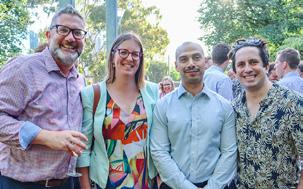


to the most often-asked questions about various of the Government’s ‘housing crisis’ initiatives. There were acknowledgements, awards bestowed and a great sense of harmony washed the room. Much applause followed.
The rhythm of the year is not complete without attendance at VPELA’s main events. Imagine a May without the VPELA Ball (what buoyant theme will have usually normal people dressing up this year?), the hoot that is the YPG Trivia Night in March, ‘conference by the sea’ (or maybe not this year) in August and, of course, December drinks (much more relaxed than many office ‘parties’)? And, of course, there is always intrigue and speculation concerning the forthcoming edition of Revue. Will my photograph be in it (and how many times) and who will I be photographed with? Go on, you know who I’m speaking to!
On a final note, there’s fashion. Members broke out their festive colours and some were wearing the sequins they bought early for the Tay Tay concerts scheduled in the New Year. Some say the look for the coming year can be gleaned from what certain style-masters wear to VPELA’s Christmas drinks. December at Zinc gave certain hints of a more formal year approaching. Many it seems are completely over the active wear, T-shirts and Pj’s that lingered post Victoria’s utterly forgettable COVID years. Colourful, playful clothes for women and restoration-style ties for men were clearly the tip for 2024.





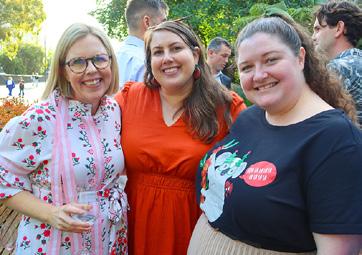



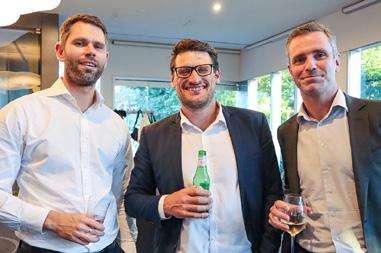



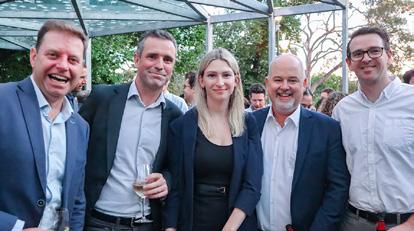



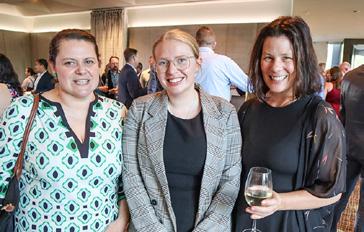









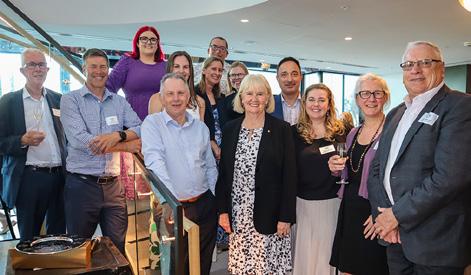
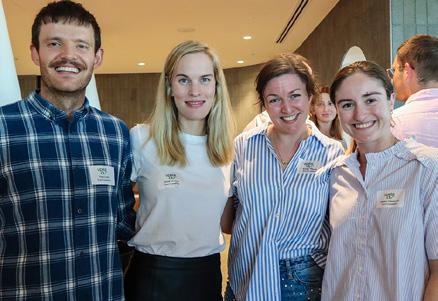

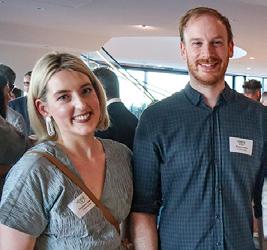






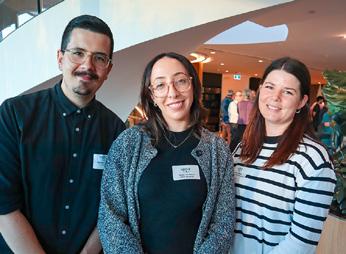



On 30 November, the VPELA Young Professionals finished off the year enjoying some well-earned time in the sun at the Fitzroy Bowls Club.
The Christmas Party turnout was outstanding this year, with a mix of young professionals competing for glory on the bowling green. The event included some great food, drinks and conversation – and a bit of rain, but that didn’t stop us. After the bowls club, the night continued at the Tramway Hotel with some more drinks, chatting and bonding between disciplines.
It was a great end to the calendar of events for the YPG, and we thank the sponsors Biosis, Taylors, Traffix Group, Contour and Urbis. The YPG is looking forward to the upcoming year of events!
Dinan McMahon, Urban Planner, Cogency













When it comes to setting housing targets, rather than threatening local government with the removal of its powers, State premiers would perhaps be better served by ensuring the targets they set are achievable.
Designed to tackle a spectrum of housing-related issues, including rapid population growth, diminishing supply, and worsening affordability, housing targets have become the ‘go-to’ policy response for governments seeking to accelerate supply and stabilise prices, typically within a specified timeframe.
Mirroring the initiatives of their counterparts in the UK, USA, NZ and Canada, governments across Australia have enthusiastically embraced housing targets as a step to addressing their worsening housing woes.
In recent months, the National Cabinet set a target of 1.2 million “welllocated” homes to be delivered over five years, beginning in July 2024. Meanwhile, the Victorian and NSW state governments have each set ambitious targets of delivering 80,000 and 75,000 dwellings respectively, per annum. Neither state has previously come close to achieving this figure.
Setting housing targets is a positive step, if for no other reason than it brings an acute focus to the magnitude of the task facing our cities and regions.
Furthermore, targets provide a widespread understanding of the dynamic demand and supply factors impacting the housing market. Whether it be declining home ownership, infrastructure shortfalls or immigration, greater transparency of an issue high in national significance should be welcomed.
Perhaps most importantly, housing targets bestow an explicit measure of accountability upon our elected officialdom, who, naively or otherwise, has enthusiastically embraced targets as part of the solution to a crisis that continues to worsen on its watch.

Determining a prescribed number and type of dwellings over a designated timeframe first requires a detailed analysis of a multitude of complex factors relating to new housing development at the local level.
Albeit sound in concept, evidence from other jurisdictions where housing targets have been adopted reveals that without undertaking detailed analysis to establish practical and realistic development potential, they are destined to fail. Furthermore, once set, housing targets can be difficult to adjust, if and when circumstances change. Housing targets lacking a sufficiently robust basis are likely to generate a series of unintended consequences. This includes the overdevelopment of certain areas, without adequate consideration of accompanying infrastructure such as public transportation, schools, healthcare facilities and parks. They can also inadvertently foster a short-term focus on quantity over long-term quality.
Development capacity, land use zoning, project feasibility, environmental factors, economic forces and housing preference all impact the ability with which new development can be delivered. Each of these factors, together with a variety of others, needs to be understood in advance of the policy development process and well in advance of the inevitable political hyperbole declaring that a solution to the housing crisis has been found.
The UK Government’s recent decision to abandon its annual target for 300,000 new homes, having never met the long-held ambition, should be instructive for local policymakers. This should include an understanding of the reasons why the target in the UK is now “advisory”, and why councils are allowed to build fewer homes if they can show hitting it would significantly change the character of an area.1





Our cities and regions are not unblemished geographic canvasses presenting a boundless opportunity to deliver a vision of the city based on an idealistic aspiration to construct a better future.
Caught between the crossfire of contentious battles over individual development proposals and the creation of perennially unfulfilled visions, the role of strategic planning in addressing the national housing crisis has perhaps never been more important.
While the entire, existing metropolis (and beyond) must do its part, simply assuming that it is the role of the ‘Missing Middle’ to pick up the slack is both lazy and ill-informed.
Contrary to the manner in which it is viewed by the planning world, the ‘Missing Middle’ is not a single geographic unit presenting a wholesale opportunity for redevelopment that can be planned in a ‘top-down’ fashion. As evidenced across metropolitan Melbourne over the last decade, the rate, type and volume of development that has occurred across the so-called ‘Missing Middle’ has varied greatly.
Some suburbs such as Brunswick and Box Hill have supported substantial apartment development, while many haven’t. Some suburbs, such as Kew and Hawthorn, have seen vast swathes of their detached dwelling stock demolished. Some suburbs, such as Dandenong and Frankston, have experienced very little highdensity development despite two decades of structure planning and government investment. There are good reasons for all of this, but these suburbs are not the same, despite all being located within the ‘Missing Middle’.
There is perhaps no better example that governments can no longer afford to impose ill-conceived, top-down metropolitan-wide directives than the discrepancy that exists between the targets set out in Plan Melbourne 2017-2050 and actual development outcomes.
Aiming to deliver 70 per cent, or almost 31,000, new dwellings in Melbourne’s established areas annually, this target has fallen well short in five of the last six years. In 2022, the number of new dwellings delivered in established areas was less than half of the target outlined in Plan Melbourne

The importance of planning in the face of a growing housing crisis cannot be overstated, at least in theory. Housing supply across Australia has remained largely unresponsive to the increasing demand, leading to rising prices without a corresponding increase in housing availability.
Addressing the ongoing housing shortfall and determining where, how much and what kind of development can realistically be achieved should be the cornerstone of government housing policy.
To improve the effectiveness of housing targets and address the persisting shortage, it is imperative to adopt a more refined and rigorous approach that analyses the specific attributes of local areas, so that a realistic and practical understanding of the volume and type of planned growth is understood. Establishing a robust reporting system for forecasting, planning, and monitoring new housing development is essential. Without such an approach, housing targets are at a considerable risk of failure.
When evaluating the current limitations imposed by the planning system, including Plan Melbourne, it is instructive to draw lessons from the UK’s Barker Review undertaken almost two decades ago.
The Barker Review provided valuable recommendations to enhance the functioning of the planning system. Central to these recommendations was the core objective of incorporating market information into the planning process, making better use of data related to prices and preferences. This included the preparation of Strategic Housing Market Assessments (SHMAs) which aimed to introduce a more evidence-based approach to policymaking, ensuring that housing supply aligns closely with the actual needs of the population.
Now recognised as a vital tool for planning housing, SHMAs aid in informed decision-making and fostering a more strategic, evidencebased approach. Continuous efforts to refine the SHMA process contribute to its ongoing evolution and effectiveness.
The intricate and ever-evolving nature of housing markets poses a formidable challenge when attempting to accurately project future housing demands, and in turn, set housing targets. The changing composition of urban populations and evolving development practices demand more sophisticated analysis, underpinned by a nuanced, evidence-based critique, if housing targets are to stand a chance.
The conventional practices and underlying assumptions in setting housing targets have long proven to be inadequate. This underscores the need for a strategic planning approach, significantly more rigorous than what is currently practiced in many jurisdictions. This would enable better policy formulation, and a system to ensure that the established targets can be met, allowing for adjustments when necessary.
In navigating the complex landscape of housing markets, adapting to the evolving urban dynamics, and overcoming the limitations of conventional practices, a strategic and nuanced planning approach emerges as the key to not only setting realistic housing targets but ensuring their successful realisation through adaptability and continuous refinement.
With almost three decades of professional experience Rob Burgess has had a variety of public and private sector roles, including in strategic planning, property research, development management and urban economics.
1 Gove confirms mandatory housebuilding targets for councils will be abolished in face of Tory rebellion – as it happened | Politics | The Guardian.
The Future Homes program is failing – not because the objectives are necessarily mistaken, but because the execution is fatally flawed.
The stated aim of the program is to “make it easier to build better apartments.” The mechanism is to provide so-called exemplar apartment design templates, and to incentivise the use of the templates by offering a streamlined town planning process.
Nobody is disputing that the intentions are worthy, but there are two critical failures of the initiative. The first of these is the limited value of the template designs when transposed to the real world. The second is the commercial viability of the designs.
As context should be the first point of reference in design, not the last, it is inevitable that the template designs will require modification, sometimes substantial, to suit specific sites. There are simply too few template designs to account for the number of variables found in site conditions. Aside from the design costs associated with amending the templates, which erode any discount on the initial purchase of the plans, when modifying the design, it is necessary to enter a “rigorous approval process” involving DTP and the OVGA – and the certainty offered around the planning process starts to evaporate.
Whilst not wanting to be too critical of the designs per se, there are some notable flaws. It is concerning to see so many of the first and second floor apartments reliant on screening to principal living spaces and terraces to avoid overlooking neighbours. The limited aspect provides questionable amenity and affects the potential value

Future Homes Design example
(Source: Department of Transport and Planning)


Future Homes Design example
(Source: Department of Transport and Planning)
of the apartments, undermining the development feasibility. Likewise, using stackers that require a de facto basement level to deliver the required car parking in the at grade parking schemes simply does not, excuse the pun, stack up. Other than being a little larger than typical, the internal planning of the apartments, whilst serviceable and easily modified, is hardly inspiring and is not well aligned with market expectations. For example, the absence of master bedroom en-suites looks like a conscious design decision in most apartment plans yet is contrary to market demand. A 65 square metre one bedroom, one bathroom apartment without a proper study, and instead showing a desk in the corner of the living room, is generous only in size. Given the price it will have to sell for, an apartment of this size must offer the purchaser far more.
The second critical failure is that it is likely extremely hard to make the financial equation work if using the design templates. Like it or not, if the financial model does not work for developers, the apartments will not get built. The template designs are inherently expensive to build, and prohibitively so in the suburbs where most of the targeted sites are to be found. Larger apartments with increased communal circulation and additional external walls simply cost more to build and therefore must be sold for more. In a climate of inflated construction costs, the equation has become even harder, if not impossible, to balance. A permit, even if delivered faster, is not worth much if the development economics cannot be reconciled. It is difficult to see why a developer would choose the template designs over an alternate, site-specific design response that provides apartments at a price people can afford.
…continues over page
The extension to the questions raised by the Future Homes initiative is interesting. The financial discount is token within the context of a development project, leaving an expedited planning process as the only real incentive. This is overt recognition that the planning process is challenging, if not a problem, and a hindrance to the delivery of housing stock in Victoria. Given the significant, and welcome, improvements that the Better Apartment Design Standards have made to Victoria’s new apartments, one must ask why it is necessary to require outcomes beyond the current standards to expedite the planning process. It is worth noting that of the thirteen nominated planning controls that are highlighted in the Future Homes program, eight are already default outcomes of compliance with the Better Apartment Design Standards. Further, the town planning controls that apply to the sites that the templates are designed for are often finite and simple, and the development outcomes are easy to define.
Surely the answer to housing supply in the targeted suburbs is to address the planning process, not the standards around design which have been debated and addressed at length in the last decade. Instead of demanding “above and beyond” solutions to expedite a
planning process, the Government should meaningfully streamline the planning process for simple sites such as these and help the multitude of talented designers, developers and builders in Victoria deliver high amenity, appropriate, site-specific apartment buildings that purchasers can afford.
The Government also needs to tackle the elephant in the room and address the inflated cost of building housing in Victoria – but that is a whole other story.
The Future Homes program has not delivered what was hoped of it, as the cost and time incentives offered are marginal. The template designs are flawed because they respond to an impossible brief, and the commercial viability of the designs is highly questionable.
Chris Hayton is an architect and Principal at Rothelowman. Chris has 20 years experience working on major projects in Australia and Europe. Fully conversant with all aspects of the architectural process, he has specific skills in building design and managing design team. He leads the sustainability division of the practice.
Welcome to our new members…
Ebony Adam Student
Rajendran Shobha Ajin Student
Ahmad Ali Lovegrove & Cotton Lawyers
Sally Austin AECOM Australia
Michelle Bashta Extent Heritage
Travis Brown Victorian Bar
Victor Cai Hansen Partnership
Georgia Carra Ecology and Heritage Partners
Jason Chan Jackson Lane Legal
Yishin Chen Ratio Consultants
Jack Chomley Metropol Planning Solutions
Mitchell Connolly EMM Consulting
Marilyne Crestias Renewable Energy Insights
Henry Crothers LandLAB
Jayden Davis-Tope Biosis
Caitlyn Deane Student
Imogen Douglass Ricardo Energy Environment and Planning
Bilaal Elakkoumi Best Hooper Lawyers
Nicolette Foster Austral Archaeology
Matthew Frame Umwelt (Australia)
Hew Gerrard Glossop Town Planning
Daniel Hadzikan Clement Stone-Town Planners
Juliette Halliday Extent Heritage
Rachel Haynes Planning Panels Victoria
Jake Heath Niche Studio
Chris Henderson Phillips & Wilkins
Annika Holden Victorian Government Solicitor’s Office
Nashita Hossain UPco - Urban Planning Collective
Katherine Hwang City of Melbourne
Phoebe James Wodonga Council

Shweta Jayasree Student
Maisie Kelly Niche Studio
Joshua Khaw Norton Rose Fulbright
James Littlewood Urbis
Ziggy Lovegrove Lovegrove & Cotton Lawyers
Joshua McGettigan Pinsent Masons
Andrew McKeegan Department of Transport and Planning
Tom Mielnik Port of Melbourne Operations
Paige Mortimer Herbert Smith Freehills
Stephanie Nguyen Student
Maria Noriega Student
Mimi Nuciforo Contour Consultants
Charlotte Poole Veris
Nivedita Ravindran Niche Studio
Siobhan Rehill Stanhope Way
Natalie Reiter Department of Transport and Planning
Brodie Richards Peter Richards Surveying
Matthew Sacco Department of Energy Environment and Climate Action
Anna Slotnick Umwelt (Australia)
Clinton Smiljanic JBS&G Australia
Christopher Smitt Metropol Planning Solutions
Isabella Tatchell-Pitman Tract Consultants
Michelle Villegas Contour Consultants
Liz Walker Student
Harrison Waller Ballarat & Grampians Community Legal Service
Sophie Williams Arup
Matthew Woollard Traffix Group
Mike Zhang Urbis

If the State Government is serious about opening up tracts of infrastructure-rich land for redevelopment, it should review the rules that allow people to contract out of the planning system.
At the present time, the provisions for removing restrictive covenants via the Planning and Environment Act 1987 (the Act) barely move the needle on releasing burdened land for housing. Arguably, they were never intended to. In Giosis v Darebin CC, for instance, Senior Member H McM Wright QC confirmed that 60(5) of the Act is useful for little more than removing “deadwood” or non-contentious restrictive covenants.1
On the other hand, while the Supreme Court does an impressive job of modifying hundreds of restrictive covenants each year, it must do so in a vacuum of public policy. As Mukhtar AsJ observed in Re DVC Management & Consulting Pty Ltd: “Recent decisions of this Court have it that town planning principles and considerations are not relevant to the Court’s consideration of whether an applicant has established a ground under s84 [of the Property Law Act 1958]”.2
Added to this is the inadmissibility of using historical analysis to understand why covenants were created in the first place. The High Court explained in Westfield Management Limited v Perpetual Trustee Company Limited: “the third party who inspects the Register cannot be expected, consistently with the scheme of the Torrens system, to look further for extrinsic material which might establish facts or circumstances existing at the time of the creation of the registered dealing…”3
The effect of all this is that applications to modify restrictive covenants are typically made one at a time, in a policy-free environment and potentially without recourse to a historical understanding as to why the restriction was originally created.
Somewhat incredibly, nobody knows how much prime urban land is tied up with these restrictive covenants, because to accurately assess this, one would need to carry out tens of thousands of title searches and subject them to individual analysis.
Moreover, private contracts to opt out of the planning system are routinely being created on greenfield sites – sometimes for ephemeral reasons of neighbourhood character but, on other occasions, for reasons of infrastructure availability. Yet as circumstances change, the reasons for these restrictions being created may be forgotten and quite possibly deemed irrelevant if a landowner wishes to remove or modify them in the future.
In 2011, the Victorian Law Reform Commission published an extensive review of the law in relation to restrictive covenants and easements, and produced a sophisticated pathway for reform. But sadly, few of its recommendations were adopted.
The more simplistic solution would be to say that, in the event of conflict between a restrictive covenant and the provisions of a planning scheme, the provisions of a planning scheme should prevail.
It is not as though there aren’t already comprehensive protections in the Victoria Planning Provisions to protect neighbourhood character and the amenity of neighbouring residents. But as Cavanough J explained in Prowse v Johnstone & Or:
118 I am not satisfied that all substantial injury would be prevented by the operation of the provisions of the planning scheme. The plaintiff relies in particular on clause 55 of the Stonnington Planning Scheme, commonly known as ResCode. However, those provisions represent a legislative compromise between the interests of developers and the interests of surrounding residents. They leave considerable discretion to the planning authorities. They cannot be regarded as a substitute for the proprietary rights of the defendants pursuant to the restrictive covenant.
Some might describe this legislative compromise as embedded in the test of net community benefit. Being bound by this principle in land development, doesn’t seem like a tremendous price to pay for sharing access to some of our most valuable urban land.
Matthew Townsend is a member of the Victorian Bar townsend@vicbar.com.au
1 Giosis v Darebin CC [2013] VCAT 825, 1
2 Re DVC Management & Consulting Pty Ltd [2018] VSC 814
3 Westfield Management Limited v Perpetual Trustee Company Limited (2007) 233 CLR 528
4 Victorian Law Reform Commission, Easements and Covenants: Final Report 22 (Victorian Law Reform Commission 2011)
5 Ibid [118].































The town planning process is a critical component of the work Design Matters National members undertake. In Victoria alone, more than 45,000 planning permit applications, with an estimated value of $32 billion, are lodged by members annually. Member surveys indicate almost 50% of all Victorian planning permit applications are lodged by DMN members, which highlights DMN as a significant stakeholder in the Victorian planning process.
We recently surveyed our members on the daily challenges they encounter with the Victorian planning system and its processes. Below is a summary of those responses, presented as a ‘wish-list’ from permit applicants.
This summary also offers some insights into how stakeholders in the planning process can help address the ongoing and growing housing crisis by streamlining the planning and decision-making processes.
1 Inappropriate requests to formally amend applications under Section 50, 50A and 57A, as part of RFIs
2 Christmas advertising requirements


Although it might be tempting to regard individual or small groups of issues as insignificant, their cumulative impact on processing times and the cost of statutory approvals pose a significant concern to our members. With over $32 billion of development projects (in the form of planning applications) presenting on councils’ collective desks across the state at any given time, reducing the processing times of planning permit applications by just five working days could equate to around $600 million in additional planning approvals/decisions. This means that for every week that processing times can be reduced, there’s a potential for $600 million worth of additional development.
Importantly, this list which follows is not intended to criticise local or state planning departments. On the contrary, DMN and our members are optimistic that sharing this type of information will assist all parties involved in Victoria’s planning process to enhance the system’s efficiency.
Some Councils appear to be placing pro-forma requests for formal amendments to applications in Requests for Information (RFIs), often unjustifiably. This resets the statutory clock, significantly lengthens decision timeframes, and could undermine the integrity of the State’s Planning Permit Reporting Statistics by artificially reducing processing times of applications.
Numerous councils require extended periods of advertising over December and January. More importantly, each council’s requirements differ, adding unnecessary complexity for regular applicants. These prolonged advertising timeframes potentially delay decisions by 2-3 weeks.
3 Unnecessary RFI requests RFIs often include irrelevant, previously provided, or unrequired information, or information that could be reasonably added as a condition of a permit. Copy and pasted, or pro-forma requests, are often to blame.
4 Multiple RFI requests
5 Internal referrals
6 External referrals
Applicants receiving multiple RFIs during the process, often from belated internal referrals, face unreasonable extensions to decision timeframes, sometimes by weeks or even months.
Timeframes for internal referrals at some councils can be excessively lengthy. For example, Heritage, Environmentally Sustainable Design (ESD), Traffic, Engineering, Arboriculture, and others. Referral officers are often inaccessible to applicants, prolonging correspondence and issue-resolution times. Additionally, referral information/conditions are often inappropriately copied into permit conditions without practical consideration of other issues.
While there have been improvements in this space, some organisations, like the Department of Transport (DoT), do not provide contact details for assessing officers, thereby delaying issue-resolution and determinations by months.
7 Bushfire prone areas: Uncertainty in information requirements
8 Flooding requirements via Council engineers where there are no planning flooding controls and information provided within the scheme
9 System for faster resolution of disputes at VCAT
10 ESD delays
11 Hertiage Overlay inconsistencies
12 Impact of planning scheme amendments on Council
13 Scheme amendments under Section 20(4) without public notice
14 Arborist report requirements on all applications
15 Online process variations
16 Councillor interference in planning decisions for political gain
17 Discretionary fees
The interpretation of Clause 13.02 varies between councils. Moreover, Fire Rescue Victoria and the Country Fire Authority’s (CFA’s) interpretation of the clause also varies. It is not uncommon for councils to require Bushfire Risk Assessments and Bushfire Management Plans (BMPs), only for the CFA to later state this information is not required. Such discrepancies can significantly increase the cost and time involved in application processing.
Unexpected planning considerations (for flooding), not mapped or publicly known, can significantly delay applications. Councils know where these issues are, and they should be addressed in the planning scheme.
The current timeframe and cost of VCAT reviews hinder the ability to contest time-critical issues like unnecessary information in RFIs, requests for s50 amendments and definitions or interpretation of policy requirements. A more expedited system for resolving such disputes would be beneficial.
Premature requirements for specific details, like white goods or light fittings before building envelope approval, can complicate the process. Overlap with Building Regulations and varying council acceptance of ESD/WSUD (Water Sensitive Urban Design) solutions also lead to unnecessary delays and expense at the planning stage.
Councils interpret Heritage Overlay (HO) requirements differently, complicating the process for applicants. For instance, it seems illogical for councils to have varying policies that provide conflicting guidance on the criteria for situating an extension to a single dwelling within an ‘appropriate’ envelope. A consistent statewide approach to such issues would simplify and accelerate the process.
Most planning scheme amendments assert they won’t impact council resources or costs, which often isn’t the case. Hiring ESD officers and imposing additional applicant requirements, like WSUD evaluations or arborist reports, demand more council time and expertise. This leads to extended application processing times.
Changes to planning schemes without public notice, such as rezoning from General Residential Zone (GRZ) to Neighbourhood Residential Zone (NRZ) within HOs, are frequently justified as efforts to update old schemes or correct anomalies. However, these changes can significantly affect landowners, for example, by reducing maximum residential heights from three to two storeys. Landowners should have the opportunity to make submissions on such changes.
The blanket requirement for arborist reports, even where no relevant overlays or laws exist, increases applicants’ costs and time. Such requirements may result in applicants exercising their right to clear vegetation on sites prior to making applications.
Councils’ movement towards online application processes is positive. However, a single statewide system for lodgement, processing and management of permit applications would be significantly more efficient than developing and maintaining multiple systems across the State.
Reducing or removing local councillors’ ability to unreasonably influence planning decisions for political gain would increase confidence in the system and reduce VCAT appeals, thereby reducing the unnecessary consumption of public funds and delays in application processing.
Councils should not impose fees for the reconsideration of ‘unsatisfactory condition 1 plans’. Any fees associated with amendments should be legislated to prevent inconsistency and discretionary charges imposed by councils. Requests for further changes often stem from unclear wording of conditions or discretionary matters, leading to the unjust imposition of fees.
18
Expansion of VicSmart
19 Standardise overlays
20 WSUD
21 Mandatory garden area requirements
Members endorse the expansion of the VicSmart process to streamline applications, particularly for matters requiring external referral advice, like inundation and bushfire risk. Similarly, Design and Development Overlay (DDO) permit triggers and similar issues should be eligible for the VicSmart pathway.
Streamline DDO and Neighbourhood Character Overlay (NCO) schedules by standardising outcomes, terminology, triggers, and requirements, eliminating outdated and complex controls no longer deemed acceptable today.
Issues relating to drainage could be excluded from the planning process to address the current overlap with building regulations and streamline decision-making.
The Garden Area (GA) requirements in residential zone provisions are widely considered a ‘blunt instrument’ that inhibits the development of residential properties, especially in well-serviced, existing residential areas. Notably, for lots smaller than 400sqm, these requirements serve to discourage site amalgamation, resulting in the substantial loss of development opportunities.
22 Permit life Varied application of the Benedetti principle by councils is a cause of confusion, unforeseen costs, and planning approval delays, especially in the case of sites with historic planning approvals.
23 Unexpected site issues Issues, such as landfill gas and potential site contamination should ideally be mapped and readily identifiable on property planning reports to avoid unpleasant and unexpected surprises.
24 Plan endorsement delays
25 Council culture
26 Simplification versus expansion
27 Transitional provisions for Amendments
Our members have reported that the endorsement-of-plans process can take months, with applicants expressing frustration with unnecessary requests for changes not otherwise required by the permit conditions. We suggest implementing a statutory timeframe for plan endorsement, ideally incorporating it within the 60-day statutory period. Delays in plan endorsement are known to postpone developments by 1-3 months.
There have been concerns about some councils’ reluctance to use the discretion allowed under the performance-based planning scheme, including, amongst other concerns, issues such as, ResCode Standards and discretionary information requirements being treated as mandatory
The planning process should not be unnecessarily expanded to cover issues, such as thermal performance and other considerations, that are already addressed by Building Regulations. This overlap only results in further stagnation in the application process.
Planning scheme amendments such as VC243, which removed the permit trigger in the Residential Zone for lots over 300sqm, have caused significant delays and increased costs for ongoing projects. While VC245 received positive feedback from our members for its longer-term benefits, its immediate impact on existing projects was, and remains, profound. Consideration of transitional provisions to protect investments made in existing applications/projects should be paramount.
Design Matters National remains committed to improving the efficiency of the planning process in Victoria and welcomes feedback on the aforementioned list.
Design Matters National (DMN) is Australia’s peak body representing building designers and energy efficiency assessors. It supports both industries through professional development programs and works closely with Federal, State, and Local
governments to ensure the quality of building design is maintained at the highest professional and ethical standards. DMN is accepted among government agencies, universities, TAFEs and industry groups as a thought leader on building design issues and continues to push for improved efficiencies and outcomes for its members.
Ashley Thompson, Clause 1; Peter Lombo, Archsign; Andrew Ferris, Andrew Ferris Building Designs.
 Alan March, Urban Planning and Disaster Risk Reduction, University of Melbourne
Alan March, Urban Planning and Disaster Risk Reduction, University of Melbourne
Improvements within the planning and building jurisdictions, in association with advances in forecasting, improved response agency capabilities and fuel management have transformed our approach to bushfire over the last 15 years. However, built environment and associated professionals have challenging and important ongoing roles to manage bushfire risks.
Overall, Australia’s bushfires are increasing in frequency and severity. In parallel, the consequences of large-scale bushfires are increasing in terms of economic losses, social disruption and environmental damage. While it is likely that climate change is causing more extreme weather events, a number of additional factors are at play.
These drivers include ongoing urban development in bushfire prone areas, challenges to fuel reduction, inadequate maintenance of structures and the existence of vast tracts of pre-regulation legacy structures. Social factors also contribute to bushfire risks such as shrinking rural populations in many areas, high rates of second homes, lower volunteering rates in firefighting and the coincidence of bushfire seasons with tourism populations.
Knowledge about bushfire risk is now a mature research field, although implementation is challenged by real-world application. The fundamentals of bushfire attack on structures are threefold: radiant heat, ember attack and direct flame contact. Complexities arise in the specifics of given sites: topography and slope, variations in vegetation, site access, size and shape of lots, the particularities of occupancy types and structures, and distances to places of refuge.
In Victoria, we are fortunate to have well-developed provisions for assessment of new or substantially modified structures. The National Construction Code’s AS-3959-2020 Building in Bushfire Prone Areas stipulates building standards that respond to the level of threat that a structure is likely to face in a worst-case scenario. This is expressed as a Bushfire Attack Level (eg BAL 12.5, BAL 19 etc), based on the kilowatt heat per square metre the exterior of a structure can withstand. Based on state-derived mapping, this affects most of Victoria outside more densely built-up areas. Importantly, AS3959-2018 only stipulates a building response to an assessment of risk at a single point in time. Accordingly, in areas facing higher levels of risk, the Victoria Planning Provisions include the Building Management Overlay (BMO). The overlay triggers more sophisticated assessment and decision criteria, and stipulation of additional treatments.
Depending on location, the BMO can allow for assessment of wider landscape and vegetation risks, road and access networks, the vulnerability of intended land uses, and proximity to places of refuge. Subsequent to assessment, the BMO provides permit condition measures to be applied in addition to the building provisions. These include ongoing enforceable vegetation management, siting requirements, availability of fire-fighting water and access, and signage. At a subdivision level, additional requirements include inclusion of perimeter roads and fire-fighting hydrants in some areas.
Many challenges remain, despite the significant improvements made to the building and planning provisions over the last two decades. The first of these challenges is that the application of building and planning provisions is often non-routine, requiring considerable expertise and multi-disciplinary knowledge to achieve outcomes. Currently, while many practitioners have taken basic bushfire assessment courses, limited numbers have undertaken training to achieve professional accreditation from the Fire Protection Association Australia. Accredited professionals can apply non-routine and science-based assessment and provision of site-specific solutions to the difficult development challenges posed by increasing numbers of sites.
Second, the large numbers of legacy sites built pre-regulation in periurban areas are increasingly at risk as they age, particularly those that are poorly maintained and which face higher insurance premiums. This can cause a number of perverse outcomes, such as uninsured occupants staying to defend properties against official advice to leave, putting themselves and emergency crews at risk.
Third, occupants of BMO affected land and AS-3959-2018 compliant structures are often unaware of the BAL and defendable space requirements of their property, leading to poor maintenance, inappropriate modifications and assumptions. This is often combined with occupants negating the fire resistance of a structure, for example by stacking wood against walls, storing petrol cans under decks or by changing building cladding without a permit.
Fourth, and finally, the management of vegetation across jurisdictions poses many challenges, even if well intentioned, due to resource issues or competing agendas and goals between agencies and interest groups.
Professor Alan March undertakes research and teaching in the area of urban planning and disaster risk reduction, including bushfire.



I’m always looking for ways to improve how we deliver our transport systems and explore opportunities that can create better outcomes.
So, when I recently reviewed a plan for a residential subdivision in one of Melbourne’s growth areas, I was surprised to see that 31 per cent of the total site area was allocated to non-arterial road reserve, like local roads. That’s right; a third of the site was road reserve!
Surely, this can’t be the norm, I thought, but after going back to review the fifteen subdivisions I’ve recently worked on, a surprisingly large proportion of subdivisions are given over to road reserve. Whilst 31% was at the upper end of the range, on average 24 per cent of the site

area was assigned to non-arterial local roads. That’s a quarter of land within residential subdivisions!
Each subdivision responds to local conditions and the street typologies vary to meet these conditions; however, the vast majority of non-arterial local roads are the typical 16-metre Access Street. A 16-metre-wide Access Street comprises a 7.3 metre-wide road pavement (with parking on both sides of the road) with the remaining width accommodating paths, landscaping and service utilities like gas, water etc. Now, follow me here: if a 16-metre Access Street has a 7.3-metre-wide pavement, that means approximately 45 per cent of the road reserve is bitumen.


Planning & Property Partners is delighted to announce that Jeremy Gobbo KC has joined as a part time Consultant. Jeremy joins PPP after a distinguished career at the Victorian Bar. Jeremy brings many years of legal experience in the Victorian property industry and will be a valuable resource for the PPP team as it continues to grow its market leading legal and planning teams. He will assist the firm with staff development and mentoring, strategic planning, and business development.
If we apply this percentage of bitumen to the average residential subdivision in growth areas, nearly 11 per cent of the overall site area is bitumen! That’s a hefty proportion consigned to the transient movement of private vehicles.
Surely, we can come up with a better solution which delivers an outcome that doesn’t just cater to private vehicles.
This got me thinking, why are we providing so much pavement area? A quick review of the background to each of those subdivisions provided me with the answer: on-street parking.

https://www.pppartners.com.au/

There is a long-held belief by those working in growth areas that subdivisions must provide one on-street visitor car parking space per dwelling. This car parking is provided in addition to the double garage situated on each lot and the ability to accommodate another vehicle in the driveway within the garage setback. In essence, we are essentially designing our subdivisions for a car parking provision of four spaces per dwelling.
Whilst growth areas do have higher car usage than inner and middle Melbourne, this level of car parking provision is well above the statutory requirements and the actual demand for parking in growth areas. For context, the average car ownership in the growth areas is 1.98 vehicles per dwelling based on Census data, with an on-street parking demand in the order of 0.5 spaces/dwelling.
What if, rather than providing countless hectares of space for onstreet parking, we reduce our local road pavements from 7.3 metres to 5.5 metres and provide parking on one side of the road only, rather than the current two-sided parking arrangements? Or, if local conditions require parking on both sides of the road, we provide pockets of 7-metre pavement with the majority of the length being 5.5 metres. This width of 5.5 metres is set out in various design manuals and still accommodates two-way traffic flow with intermittent kerb side parking. Importantly, it removes 1.8 metres of pavement from the cross section. With this simple change, the proportion of bitumen goes from being roughly half the cross section to one-third of the cross section.
We need to remember, too, that these streets are intended to function where “…traffic is subservient, speed and volume are low, and pedestrian and bicycle movements are facilitated” as set out in Clause 56.06-8 of the Victoria Planning Provisions. By narrowing the pavement cross section, we introduce friction that reduces vehicle
speeds and promotes pedestrian and bicycle movements in line with the intent of the VPP.
It might not be immediately apparent, but the State Government’s announcement to ban gas connections in new homes from the start of 2024 provides an additional opportunity to reconsider our road cross sections. Currently, gas services occupy around 0.5 metres within our road reserves and service providers are reluctant to allow paths or landscape above their pipes. With the removal of gas connections from future subdivisions, this 0.5 metres becomes available for other uses. In theory, all road reserves could be reduced by 0.5 metres but, rather than reducing the road reserve width, if we combine this portion with pavement changes we achieve 2.3 metres of road reserve width that can be put to better use.
Think of what we could do with this additional road reserve! What if we added 2.3 metres of landscape back to the road reserves? Imagine the opportunities for significant landscapes to increase amenity and shade with the effect of reducing the heat island effect and greening our streets.
What if we converted one of the footpaths to a shared path? Think of the connected active transport network we could create with all these shared paths throughout the subdivision which, in turn, would promote alternate transport modes and reduce reliance on private vehicles.
Maybe we return some of the additional width to the subdivision? With the current housing affordability crisis, this additional width could increase the supply of dwellings put to market.
Now, I’m not suggesting that we get rid of the 16-metre Access Street we know and have come to love; it still has a place in our subdivisions and should still be used where appropriate. But we have subdivisions which are characterised by short lengths of 16-metre road that service only a small number of lots. These lots don’t need the additional capacity afforded by the typical 7.3-metre pavement and they could benefit greatly from additional landscape or pedestrian connectivity.
It’s time we challenge the norm of private vehicle dominance in our subdivisions in favour of contributors to amenity that make a good, liveable and characterful street. Re-envisioning our growth area road cross sections offers us an opportunity to create lasting neighbourhoods.
Peter Malley has a passion for master planning and largescale developments. He has contributed expert advice to a range of significant projects including town centres, residential subdivisions, mixed-use developments, healthcare and educational facilities, working closely with clients to achieve successful and innovative responses.

This is an adaptation of Kelley Mackay and Will Young’s presentation at the VPELA Conference on 1 September 2023
Founded by Ross Harding, Finding Infinity is not your typical environmental consultant. We’re a motley crew of scientists, project managers, architects, artists and engineers with a sprinkle of finance on top. Each person brings a different lens and a different type of experience.
In 2019, we started pulling together a strategy to transform Melbourne that ended up determining that it will cost the city around $100 billion to transform from a consumer to a producer by 2030.
We started by looking globally. What happens if we take all the financially viable initiatives from all around the world and we implement them in Melbourne? We scoured the world and found the best selection of examples we could, at both project and city scale, including buildings and policy, and came up with 10 initiatives. We then looked at what Melbourne is currently consuming and what it would take to implement all 10 initiatives.
Our strategy started with transforming the existing city. We start by electrifying the transport system, storing energy in the batteries of the 1.3 million newly electrified cars. Then we electrify all our buildings


and retrofit them for energy and water efficiency. Two thirds of the buildings that will exist in 2050 already exist today. Then, we generate renewable energy from the rooftops and transform the Latrobe Valley into a renewable energy region. We treat and reuse all our city water. We recover energy from our organic waste and transition to a circular economy. Finally, we check that new buildings do no harm; they’re self-sufficient, zero carbon and circular.
It would cost about $100 billion between now and 2030, pay for itself in under 10 years and provide ongoing jobs.
How would we do it?
Inspired by our popular solar-powered techno party called Off The Grid, we realised we needed to harness technology and power, creating tangible experiences – rather than just talking about it. So, we created example projects with the private sector, allowing people to touch and feel. This would serve to de-risk the introduction of a much-needed policy.
We invited 15 of Melbourne’s best architects around for dinner to help us visualise what these pilot projects might look like. Even though we’d only envisaged 10 projects, we ended up with 15. Once we had all these concepts, we launched them to the public at Melbourne Design Week in 2021. Each architect created a project prototype to demonstrate it – and secure funding.
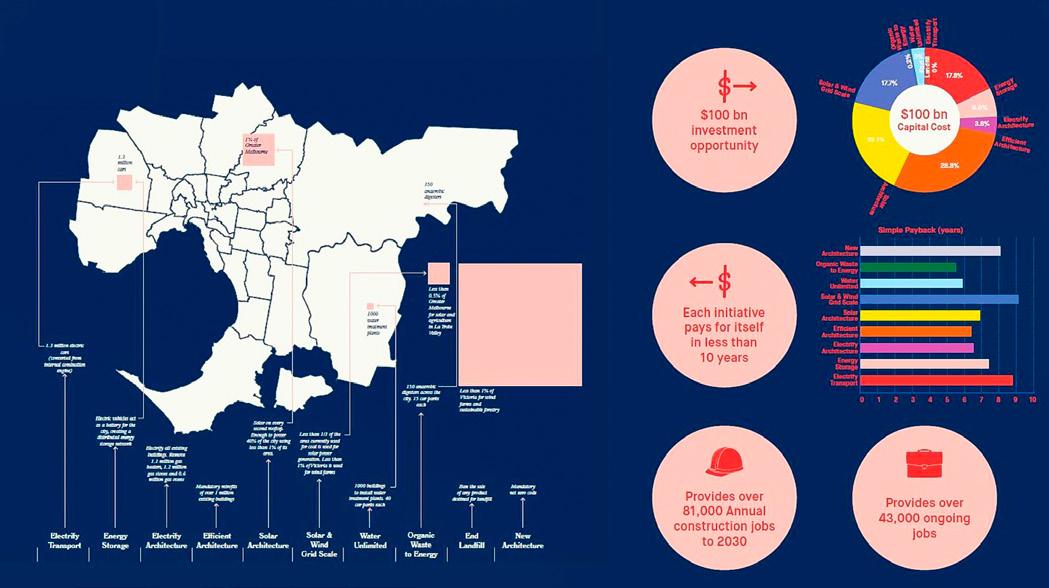

Dinner party conversation – what was discussed?
Electrifying transport
Grimshaw Architects, Greenshoot Consultants and Greenaway Architects re-imagined the future of the service station as a healthy and educational experience, where cars are charged and converted. Foolscap Architects proposed an alternative to air travel, using
existing tracks and carriages. They re-imagined trains as mobile food and beverage destinations, with co-working and sleeping spaces.
Energy storage
Hassell re-imagined the existing city car park. By day, it’s a collective battery storage. By night, it comes alive as a cultural venue. In Southbank, Clare Cousins proposes to reactivate the commercial zone through an adaptive reuse of the podium parking as both community spaces and electric storage.

Fender Katsalidis showcased the value of retrofitting and highperformance envelopes. Across the city skyline, John Wardle Architects reclaimed Melbourne’s rooftops and proposed solar modules for educational, civic and performance and recreational uses.
Solar, wind and water
At grid scale, Ha Architects transformed the Latrobe Valley into solar agriculture, where the use of the land is shared for both energy and food production, and visitors experience food grown directly from the site. Towards unlimited water, Openwork normalised the use and drinking of treated black water through a nightclub under the MCG. While out in the suburbs, NMBW transformed a typical cul-de-sac into a shared and permeable landscape where neighbours interact, work and play.
Waste to energy
At the Fitzroy Pool, WoWoWa transformed our food waste into energy and fertiliser. Ten tonnes a day of food waste would be collected from surrounding businesses and converted into biogas used to heat the sauna, spa and the indoor pool. At the Queen Victoria Market, Six Degrees proposed an anaerobic digester to convert the food waste from the market into biogas to power a moonlight cinema, the market’s forklifts and the food outlets.
Ending landfill
Edition Office created a social enterprise that teaches repair and reuse. Dreamer created a retrospective art gallery celebrating the beauty and value of the discarded.
Net-positive architecture
Last, Kennedy Nolan and Fieldwork Architects demonstrated that new buildings can not only be net-zero, but have a net-positive energy output.
Some of these prototypes have already come to life…
Kennedy Nolan’s Willam Ngarrang Retrofit Apartments, Fitzroy
As Australia’s first apartment building with a net-positive energy output, it’s simple, low tech and cost effective. Maintaining affordable rent and slashing energy bills was paramount. The solution utilises a combination of passive and active systems to reduce the dependency on heating and cooling. It will have more than a 100% reduction in water flow, and a potential for a 100% reduction in waste. It has a softness and a comfort, both in temperature and acoustics, that is unfamiliar in most Australian homes. And there’s a generosity to the shared spaces.
Most incredibly, it’s a win-win for both landlord and tenant. It achieved the targeted 4% capital return for the owner, and we calculated that tenants are $33 a week better off, as well as having a lovely place to live. So, the model works, and the power of it is that it can be replicated to the thousands of other apartment buildings needing upgrading across Melbourne.
An adaptive reuse of an existing warehouse into a new co-working space, this project produces more energy than it consumes over the course of a year. It achieves a 55% reduction in mains water and treats waste on-site. It’s a light-filled, healthy and welcoming workplace. And it’s not very often you get to work inside your own project. We’re moving into this space and will be monitoring its consumption to better understand its performance, its responsiveness and how it compares to the original expectations.
This is a community hub in the heart of Brunswick – part new build, part heritage. The vision was to create an exemplar campus of buildings that had minimal environmental impact. After a few setbacks, it’s still targeting to produce more solar than it consumes.
Designed as a new office building for Cobild, it will be net-positive in energy, passive house equivalent, and is targeting about a five-year payback period on all the initiatives. But below ground, it’ll be the first project in Australia to have a 10-tonne-a-day anaerobic digester in its basement, which takes the food waste from 340 restaurants across Melbourne and converts it to energy that’s exported back into the grid.
This is to be an authentic net-zero building with one floor of a typical office, one floor of a typical apartment, and a typical rooftop garden to show possibilities. It uses a range of cost-effective, pragmatic, and practical initiatives that on their own are not that innovative, but when combined, create something never before done. We’re also working on having it be off the grid in the city. Its lessons will be scalable and replicable, with the aim of accelerating towards a net-zero building code.
Finding Infinity is currently working on four retrofits to demonstrate to industry the future opportunity in retrofit. We know that retrofitting all commercial buildings across Melbourne presents a $55 billion opportunity for the construction industry, creating over 54,000 jobs. And by not doing it, Melbourne’s construction industry is missing out on $8.29 billion and 7,000 jobs annually.
Late in 2023, we launched A New Normal in Sydney at the Powerhouse Museum, and we’re working towards launching in Perth soon – to help more cities around the world transition from consumers to producers.
Will Young leads detailed building simulations and cost benefit analysis on projects ranging from houses to citywide master plans. With a background in engineering and finance, his key role involves investigating the financial viability of a range of environmental initiatives through identifying impacts on both capital and operational expenses, translating this information into strategies for precincts and buildings to minimise their environmental impact. Kelley Mackay brings design excellence and innovation to each project to create exceptional projects with positive impact. She contributes over 18 years of experience delivering outstanding projects across a wide range of sectors.

Hew Gerrard
The Fast Track List (FTL) was set up in 2022 to ‘quickly and efficiently’ deal with post-permit applications. A unique characteristic of the FTL is that there is no opportunity to amend plans with PNPE9 not applying.
However, in Clifton Springs (Holdings) Pty Ltd v Greater Geelong CC [2023] VCAT 1200, amended plans were allowed to be substituted. In this matter, the permit applicant argued that the nature of the FTL did not amount to a statutory constraint to s127 of the VCAT Act 1988. Further, it was argued that amended plans were only being submitted because the extent of the Council’s concerns was now better understood.
In considering other issues, including efficiency and fairness to Council, the Tribunal allowed the amendment of plans as sought, stating:
In the context of the facts of this case I consider the substitution of the plans is the most efficient and just way forward.
While unlikely to be encouraged by the Tribunal, this does open the possibility for the amendment of plans in other FTL matters, particularly if the amended plans are responding to new information or advice.
Unique Food Trucks Pty Ltd v Wyndham CC [2023] VCAT 1205 concerned a proposal for 12 food trucks and an ice cream shop in the IN3Z, but with a total of only 10 seats.
The Council argued that what was proposed was effectively 13 separate land uses and/or that a food truck park should be considered an innominate use and/or that the anticipated 20 staff and 70 patrons went well beyond the scale/intensity envisaged for a takeaway food premises.
The Tribunal disagreed, stating a ‘use’ permit was not required on the basis the proposal constituted a ‘take away food premises’ and that: Irrespective of the number of take away food options, the definition for take away food premises does not include any reference or inference to the number of separate businesses or take away food offerings on a site. It refers to land used to prepare and sell food and drink. I do not consider the definition places limits on the intensity or scale of how land may be used for providing for take away food.
The Tribunal’s decision opens some tantalising questions including where the other 60 patrons will go, and more broadly the potential impact on industrial land supply if such ‘large’ take away food premises were more commonly provided given the as of right status in both the IN3Z and IN1Z.
Hew
GerrardMost planning schemes now contain an ESD policy, with most councils employing inhouse ESD advisors. Sustainable Design Assessments or similar that are prepared are often referred to said ESD advisors, who most often have a series of technical comments in response. These comments often work their way into a condition of a permit, which can often lead to a condition being very lengthy.
In Chen v Whitehorse CC [2023] VCAT 971, the Tribunal had reason to consider such a condition, this one containing 10 parts (though spread over two conditions). Having interrogated the relevant ESD policy and the referral comments, the Tribunal concluded for several reasons that the extent of detail was inappropriate and a simple condition requiring the submission and approval of an SDA to the satisfaction of the responsible authority would suffice.
This a logical decision which should be adopted more broadly and applied to other unnecessarily long conditions which contain considerable detail e.g. some engineering conditions.

The Department of Transport and Planning (DTP) has been busily working away on the recently launched ‘Future Homes’ program. It aims to provide for more efficient use of land in the General Residential Zone (GRZ) and an accessible, streamlined development application process based on ready-made architectural plans.
For a site to be eligible for the streamlined process, it must meet certain criteria based on site area, not be subject to a heritage or neighbourhood character overlay, and be located within the GRZ and proximate to a railway station and activity centre.
Uptake in the program has been limited thus far, with more recent developments in the program being implemented, namely the:
• significant price reduction for the architectural plans from $1,500 to $150 based on substantial State Government subsidisation
• implementation of a Future Homes layer into VicPlan, which plots the location of eligible sites across Victoria.
…continues over page


Historically speaking, State-led initiatives that seek to stimulate the streamlining of residential development have been very successful. The ‘Small Homes Service’ (SHS) of 1947 was launched by the Royal Victorian Institute of Architects in partnership with The Age and headed up by revered architect, Robin Boyd.

Like Future Homes, this service provided those eligible with readymade architectural plans at the affordable price of just 5 pounds each. The single storey house designs were tailored to the market demands of the ‘baby boom’ era and were geared towards suitable and affordable housing for young families. Future Homes is, instead, focussed on providing medium density housing, given the very different population landscape and the housing shortage in greater Melbourne today.
The uptake of plans purchased under the SHS was incredible, with some 1000 sold within the first week or so. By 1951, these plans were being drafted by a variety of leading local architects and SHS dwellings constituted over 10 per cent of new housing development in Victoria.
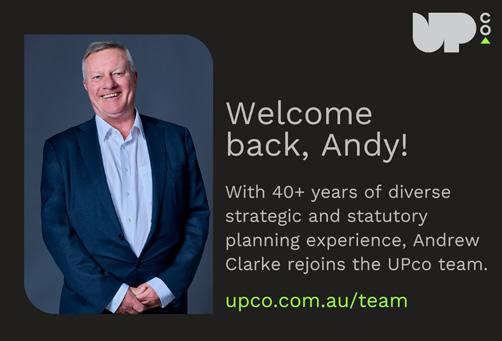
It is important to note that under the Future Homes program, a development is not constrained by the purchased plans and can adapt them, with input from any architect of their choosing, to fit the site in question.

It is encouraging to see the Department prioritising developmentready land, emphasised by such heavy Government subsidisation of the architectural plans. Hopefully the recent price reduction, in addition to a collective effort from the broader development industry with increased participation from leading architects (as was the case with the Small Homes Service), will see a plan purchase uptake and, in turn, the provision of more well-located and well-designed housing for Victorians needing it.
 Lewis Moore, Senior Planner/Urban Designer, Ratio
Lewis Moore, Senior Planner/Urban Designer, Ratio
Clause 63.11 of all Victorian planning schemes enables existing use rights to be established by proving 15 years of continuous use.
On 12 February 2024, this clause was amended as part of Amendment VC254.
The amendment changes the words in clause 63.11 so that the 15 year period being relied on to establish existing use rights can be at any time before the date of the relevant application or proceeding. It remains the case that this provision cannot be relied on if, during the 15 year period, the responsible authority has clearly and unambiguously given a written direction for the use to cease by reason of its noncompliance with the scheme or if, at any time, the use has been held to be unlawful by a decision of a court or tribunal.

This change is significant because the words previously used in clause 63.11 were interpreted by the Supreme Court in Octopus Media Pty Ltd v Melbourne CC [2017] VSC 429 as requiring the period of 15 years to be the period immediately before the date of the relevant application or proceeding. This meant that, in the case of a longstanding use, clause 63.11 was not available if a responsible authority issued a direction for the use to cease before an application was made to establish the existing use rights.
As a result of the amendment, there is no urgency to establish existing use rights once 15 years of continuous use can be proven. Provided the use continues, an earlier 15 year period of continuous use can be relied on to establish existing use rights, even after a responsible authority has given a direction for the use to cease.
Practitioners with current applications involving existing use rights and clause 63.11 will need to carefully consider any impacts of the amendment on their matter.
 Jarryd Gray, Senior Associate at Minter Ellison
Jarryd Gray, Senior Associate at Minter Ellison
In Hopkinson v Yarra Ranges SC [2024] VCAT 124, the Tribunal considered Council’s refusal of an application for subdivision of land into four lots, the construction of an outbuilding (garage) to an existing dwelling and the removal of vegetation. Council acknowledged that the subdivision was an acceptable planning outcome. However, it considered the external access to the subject land to service the new lots inadequate, and that it would impact some native vegetation in the road reserve, if properly constructed.
It is understood, from engineering comments extracted in the decision, that Council required the construction of new combined driveways north of the existing court bowl. The applicant proposed the re-sealing of existing bitumen pavement.
The principal issue before the Tribunal was to consider whether the grounds for refusal were relevant matters to the permit application made.
Council submitted that the nexus between the proposed subdivision and improvement of the access arose from the requirements of the Bushfire Management Overly (BMO) that applies to the subject land, the road and the surrounding land, particularly regarding the requirement for firefighting vehicle access.
The Tribunal had regard to section 62(5)(c) of the Planning and Environment Act 1987 (Vic) and held that the nexus between the planning permissions sought, and any requirements for works outside the subject land, were limited to providing for access for emergency vehicle requirements under the BMO. The Tribunal emphasised that this is “the limited purpose which the requirement for any access is to be confined to” and “any further requirements or benefits beyond that fall outside the relevant planning purposes”.
The applicant’s offer to seal the eastern side of the road reserve was considered satisfactory by the Tribunal, as what was proposed would directly service the land from the court bowl to the land, “in a form that is acceptable to the requirements of the planning permission that is sought.”
 Alisa Gattini, Lawyer at Rigby Cooke Lawyers
Alisa Gattini, Lawyer at Rigby Cooke Lawyers
VPELA is pleased to invite applications for the VPELA Young Professional’s Award for 2024. This highly prestigious award is open to VPELA members between the ages of 18-35, who have been members of the Association for at least 18 months. The Award includes a trophy and cash grant of $5000 to support the recipient in undertaking independent research (domestic or international), or a course of study related to their industry, as well as opportunity to speak at our Fellows Dinner in 2025.

February saw the VPELA Young Professionals kick off its 2024 calendar with the annual Speed Networking event. The ever-popular event saw great representation from a range of industries in both the public and private sectors. Along with the great industry turnout, the 2024 version of this must-attend event included the welcome addition of students looking to move into the industry in the future.
The evening was a great success, with many new relationships made and catch ups amongst old friends. Continuing its great history, the event created further links and networks within the industry that will no doubt be the foundation for professional and personal friendships for years to come. Special thanks go to our YPG sponsors and our host for the night, Tract. Its office and outdoor space really enabled some great networking to take place.
We look forward to seeing you at our next event!






PO Box 1291
Camberwell 3124, 9813 2801
www.vpela.org au






Established in 1989, the Association holds regular seminars, social events and a conference annually. It also reviews legislation, provides high level advice to Government and makes submissions to all aspects of land use planning. If you have any questions or are interested in joining the Association, contact Anna Aughterson, Executive Officer – admin@vpela.org.au